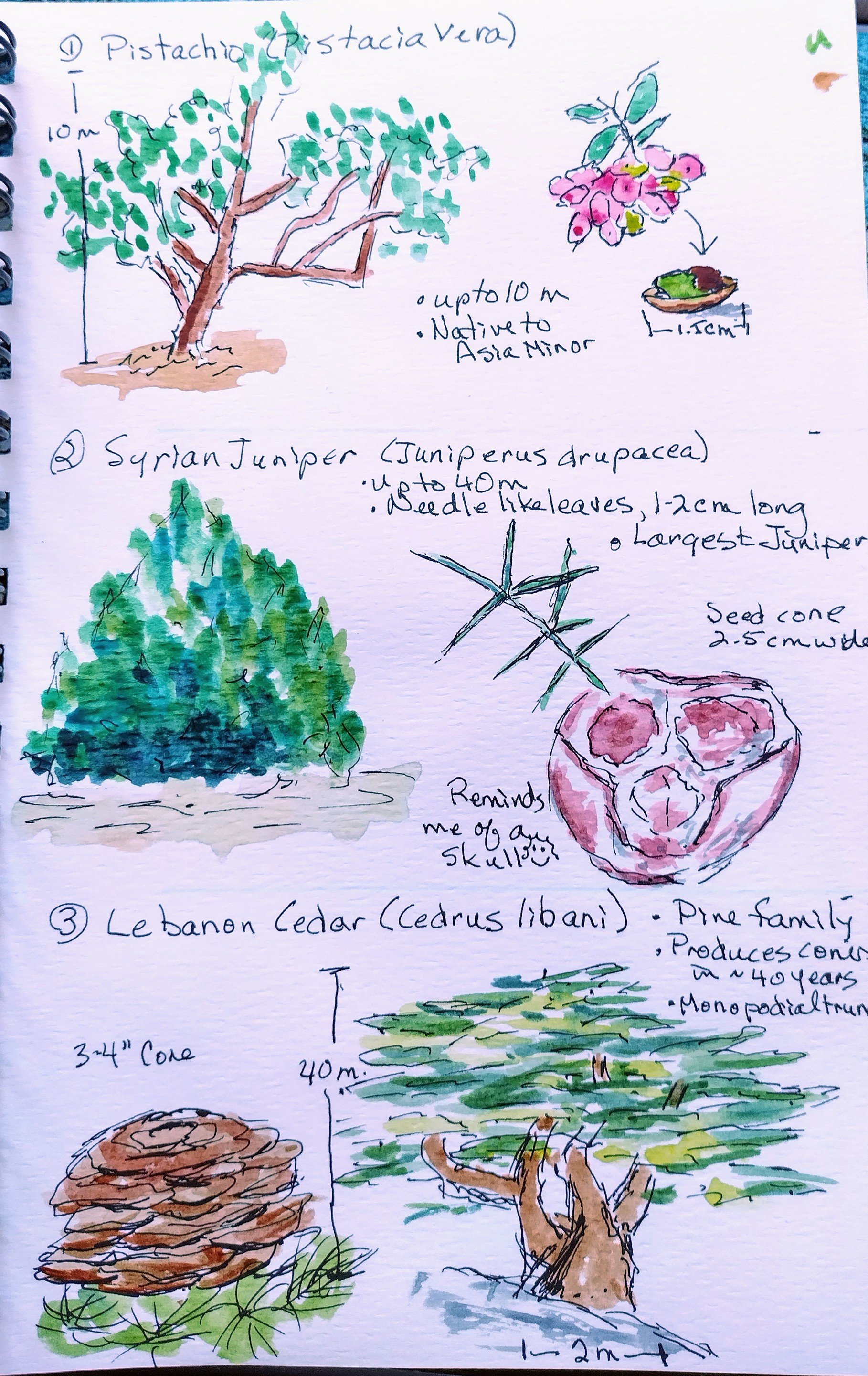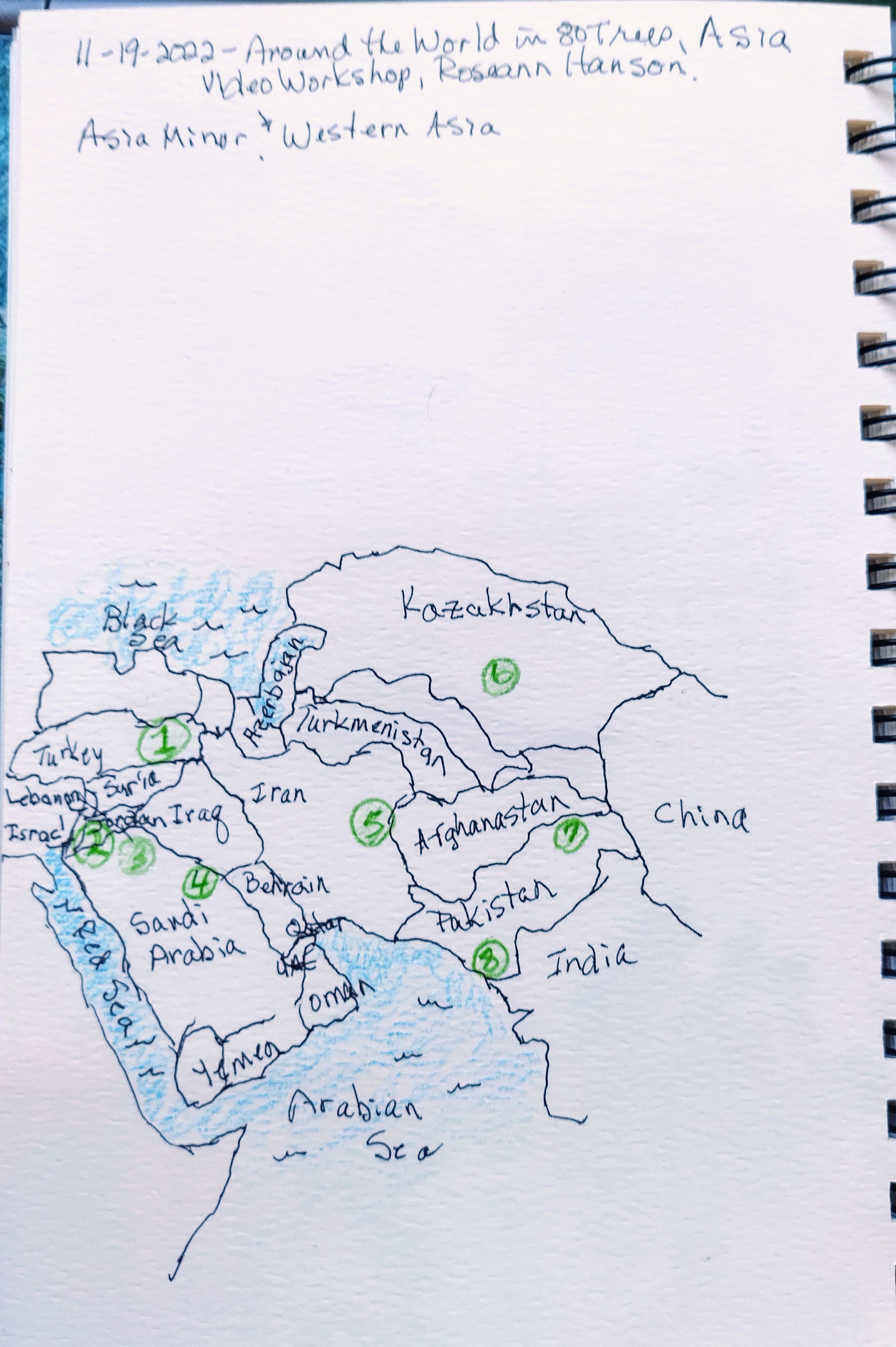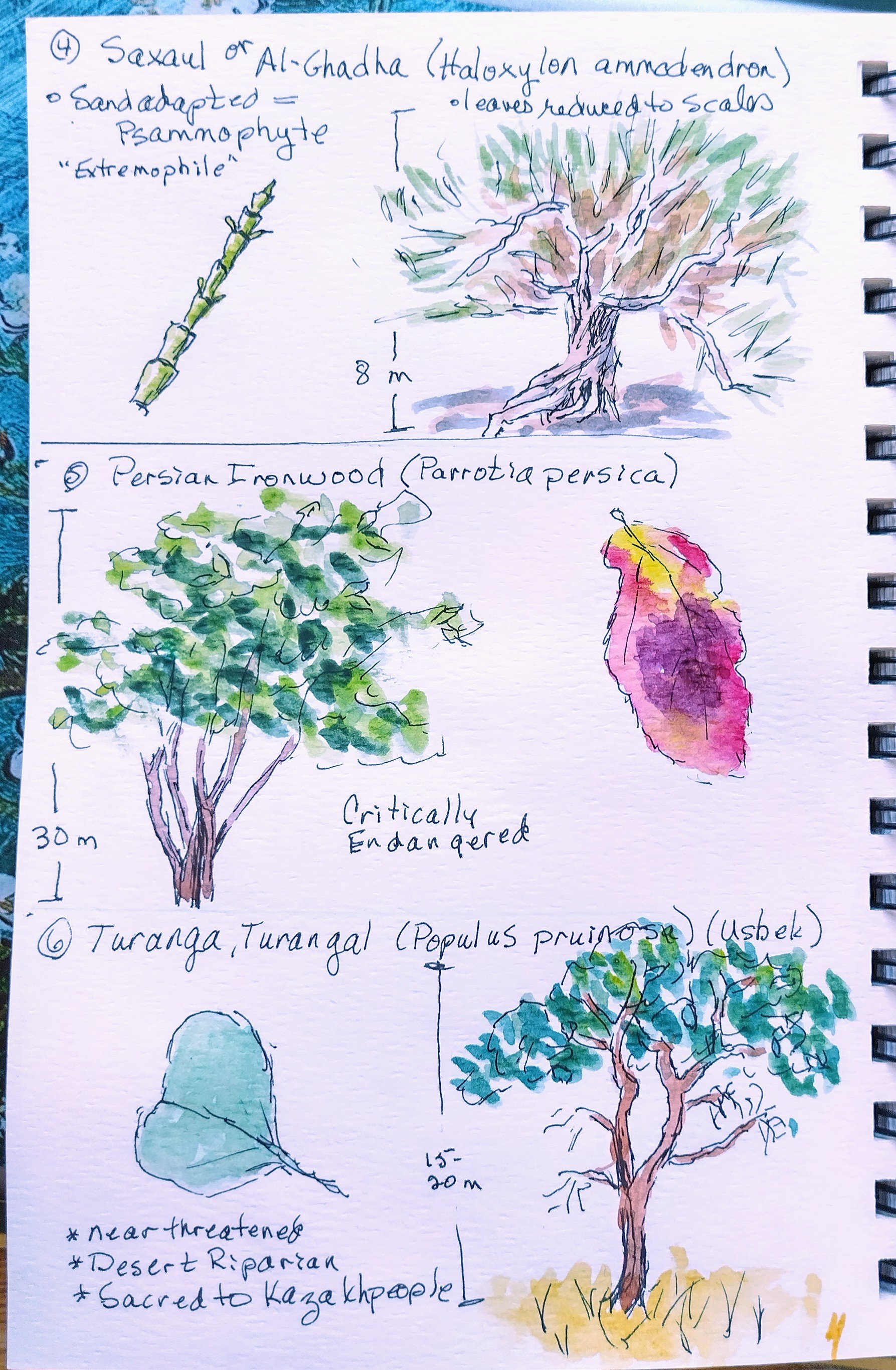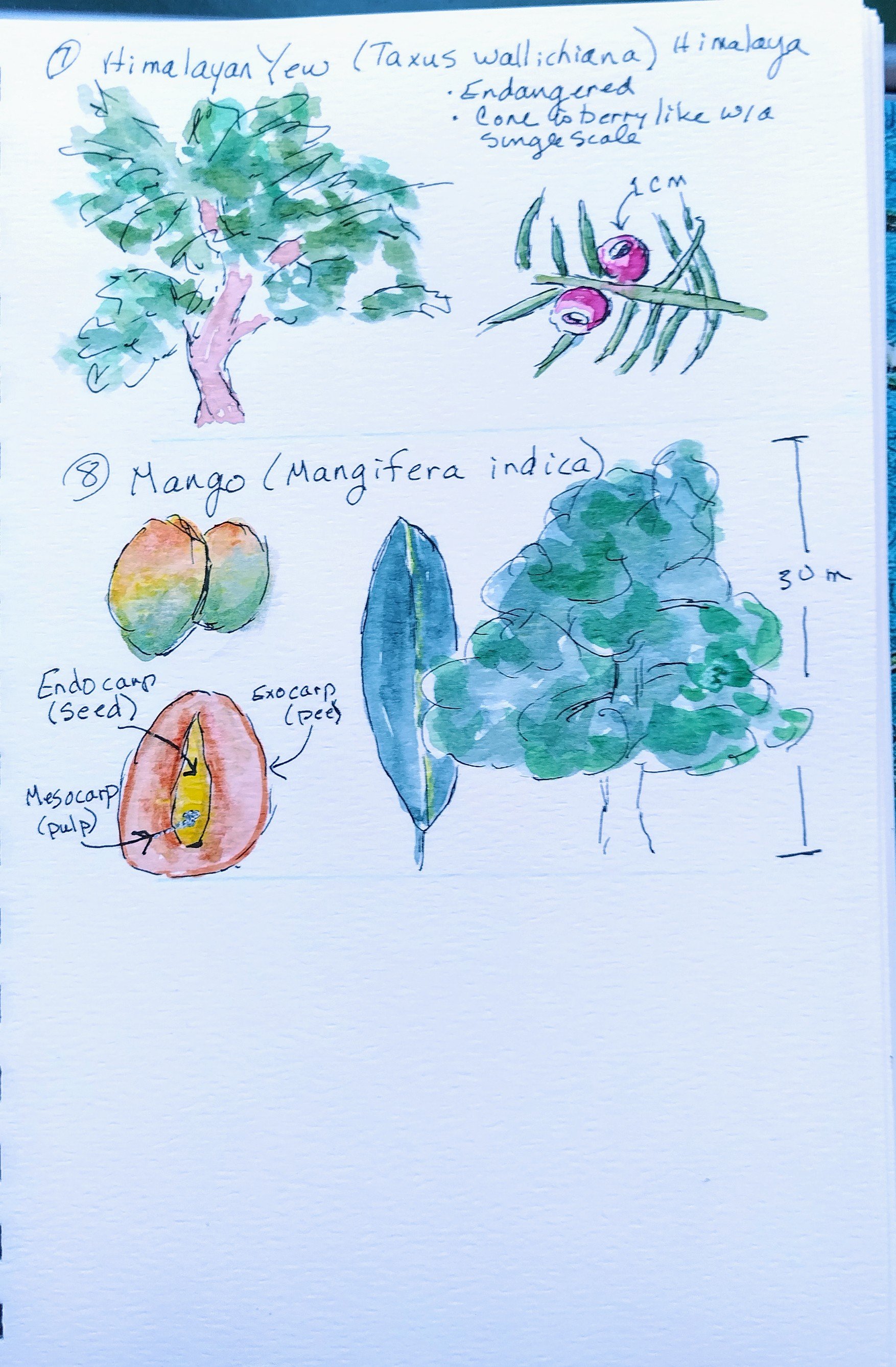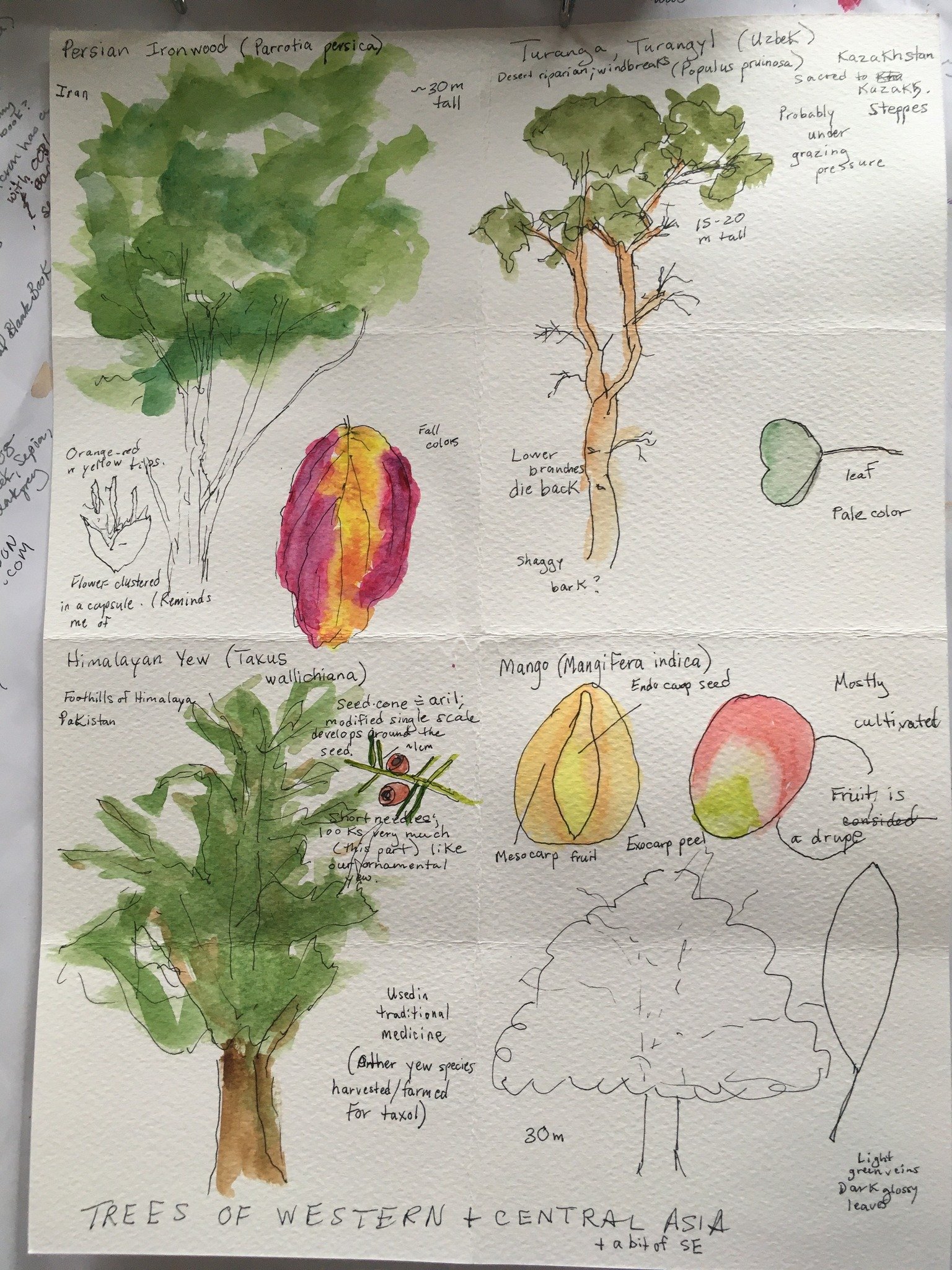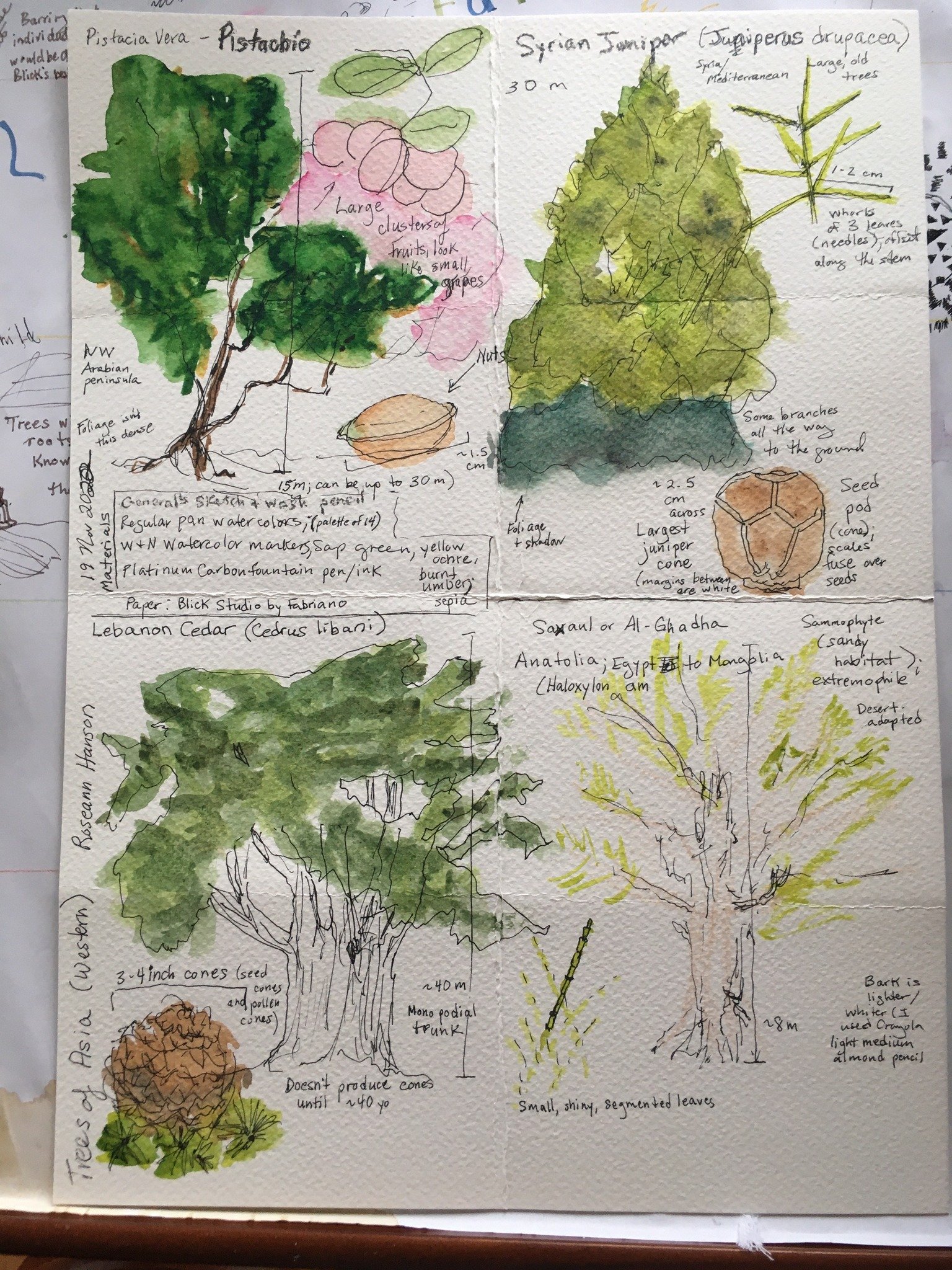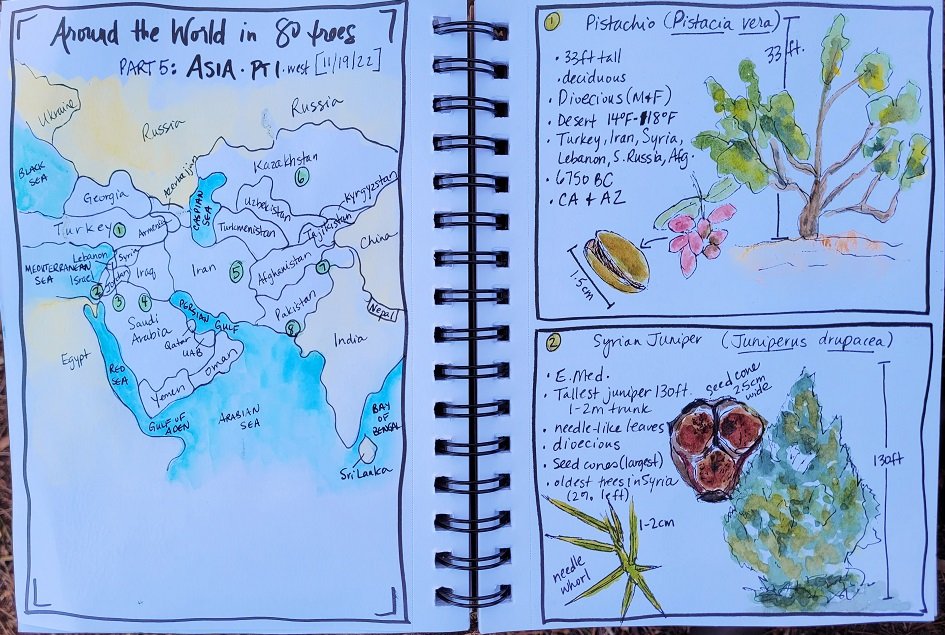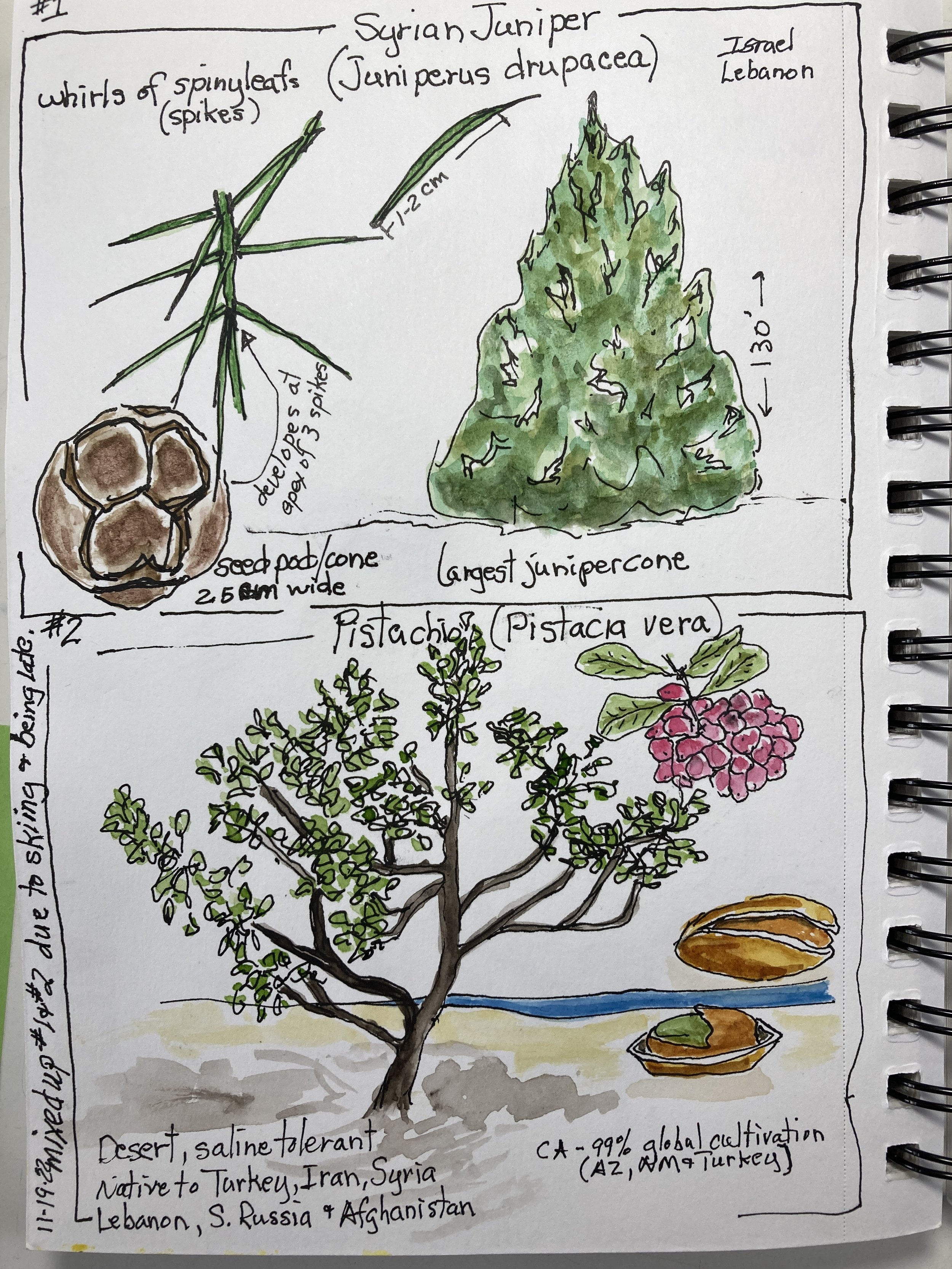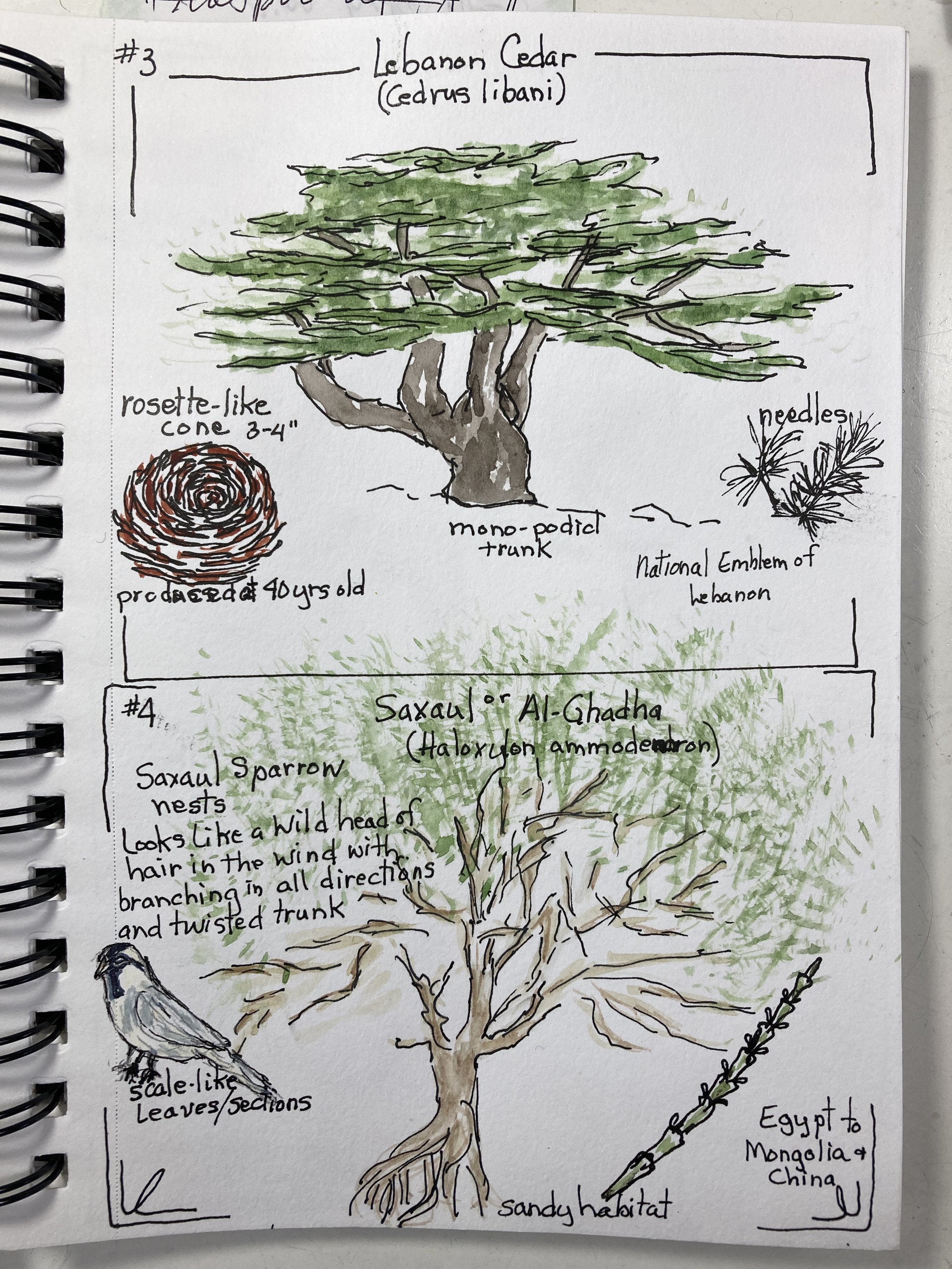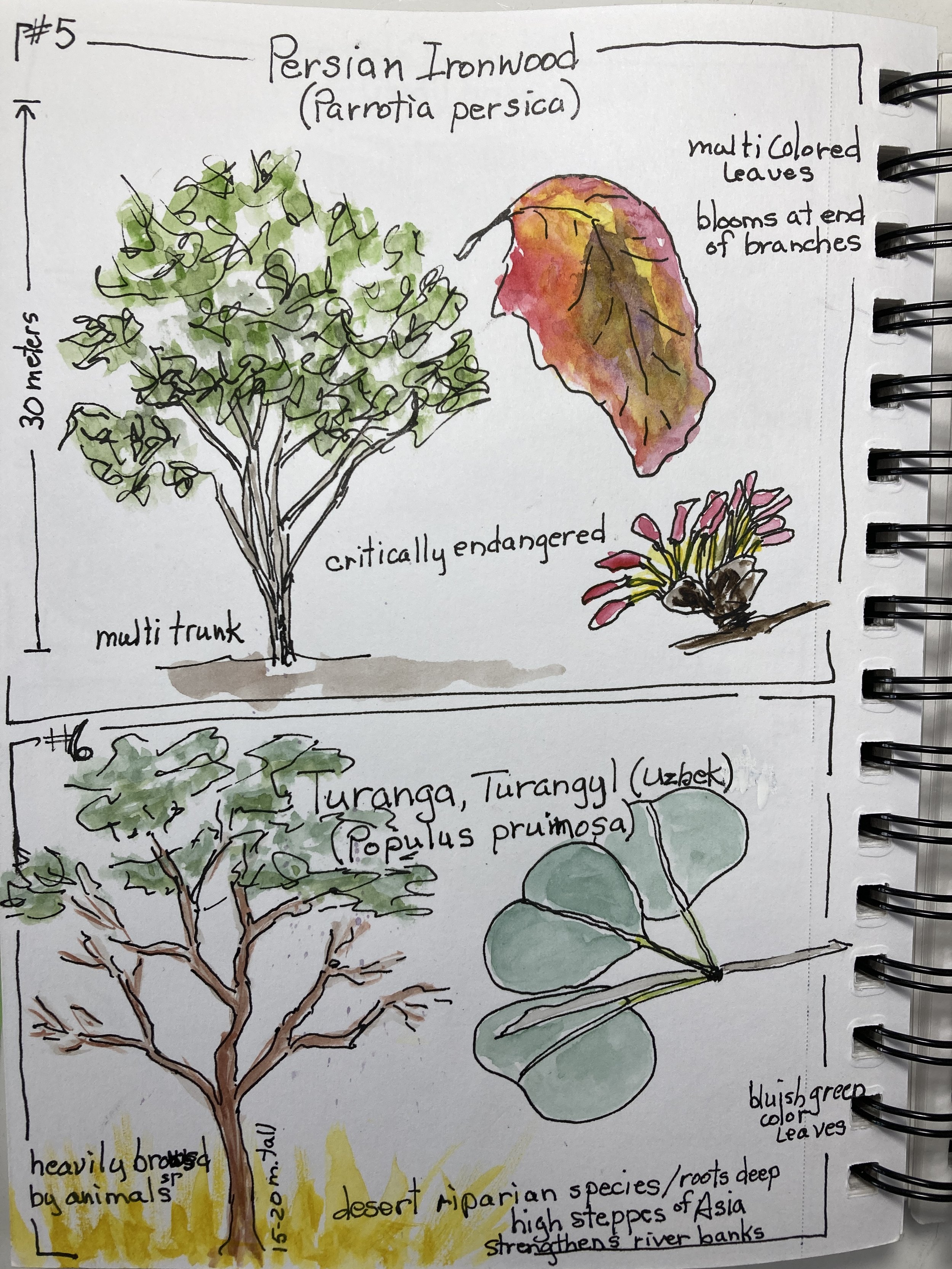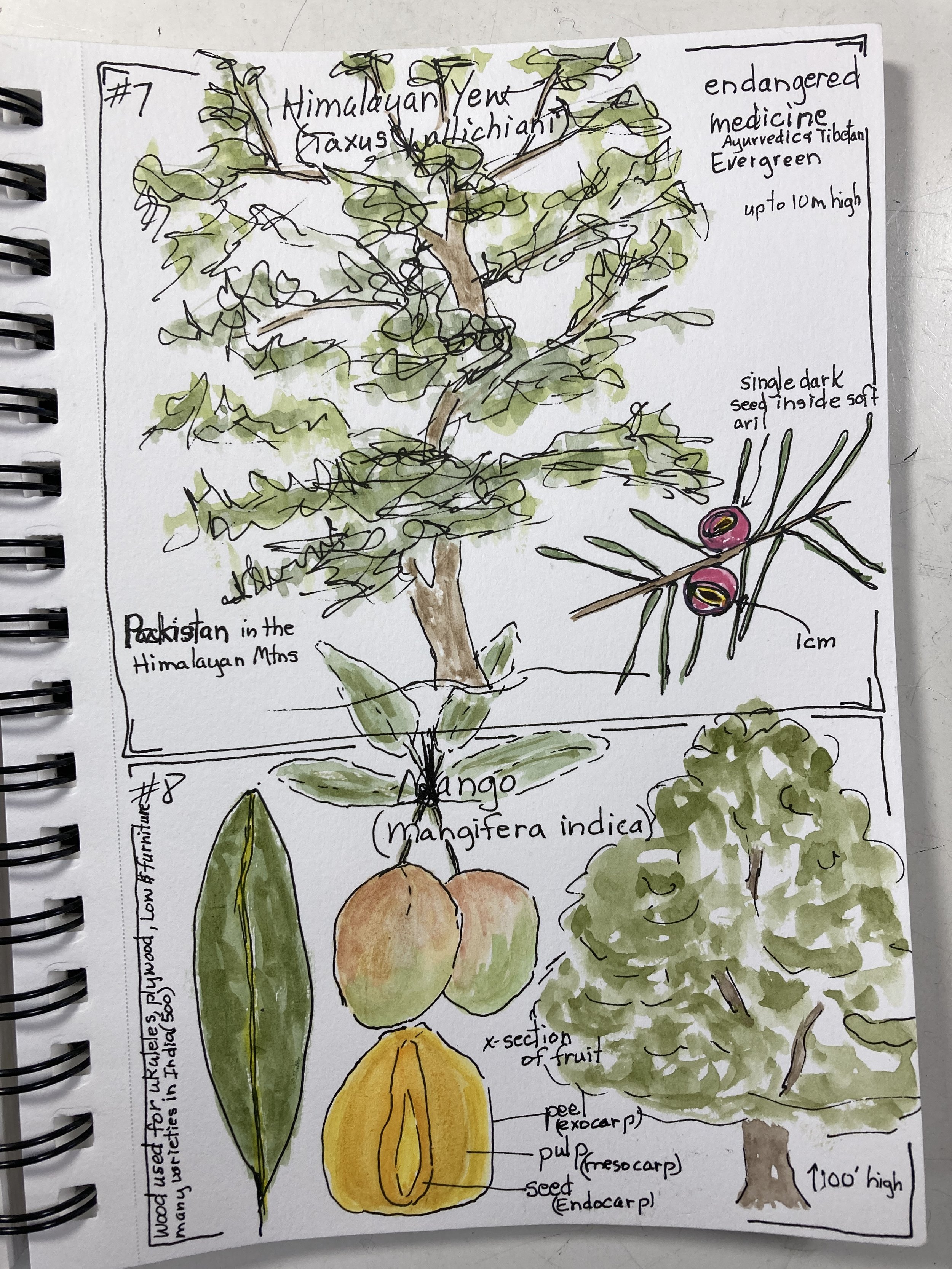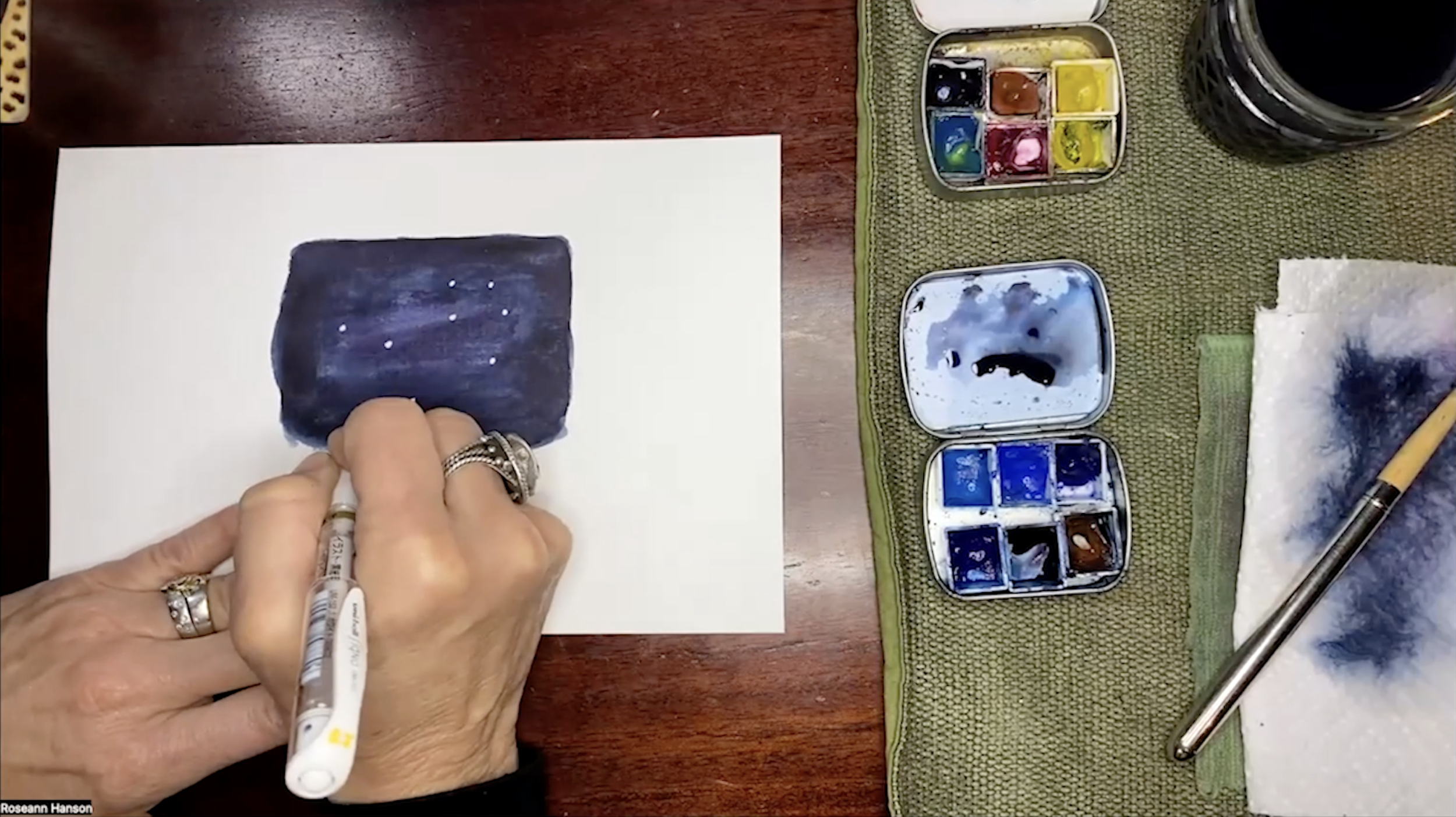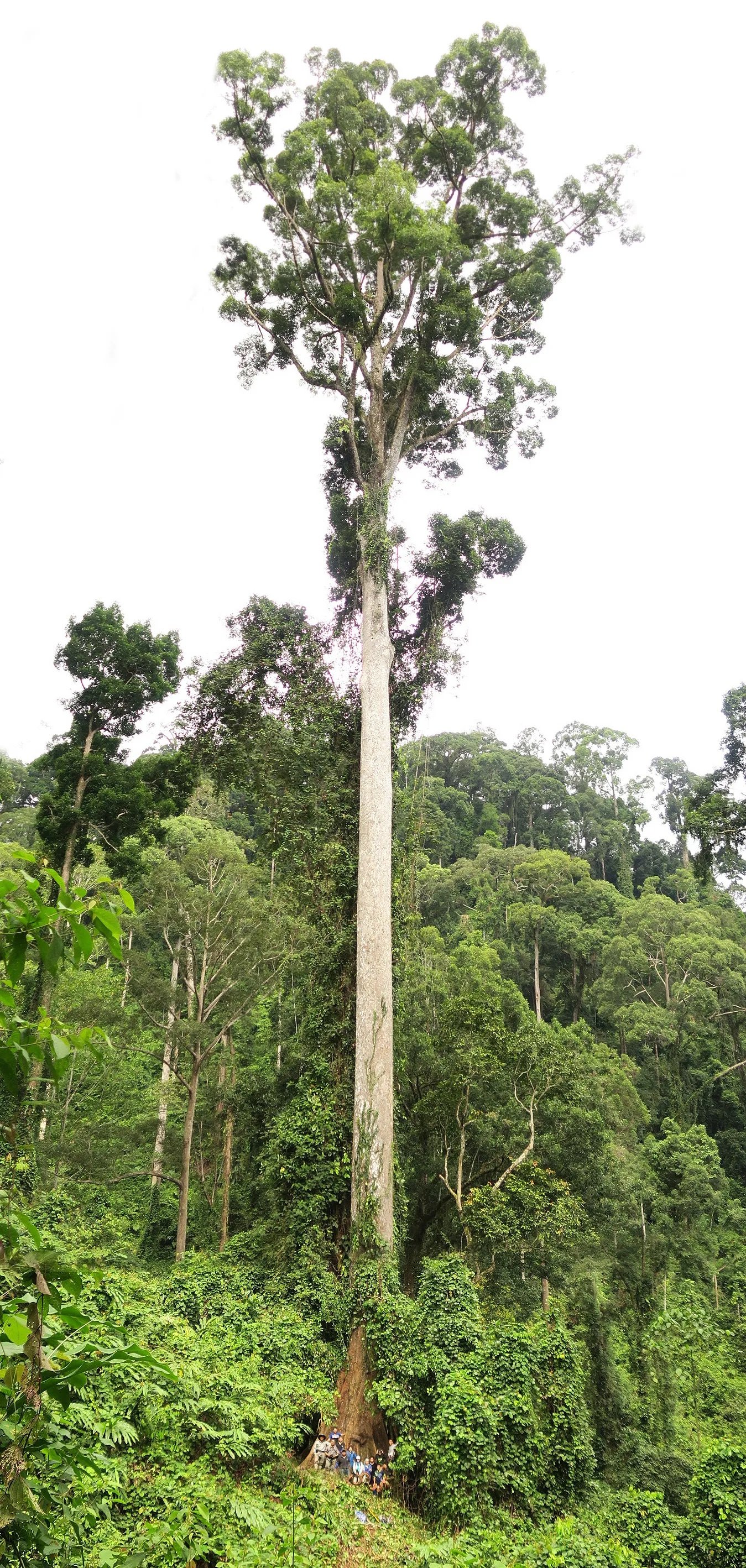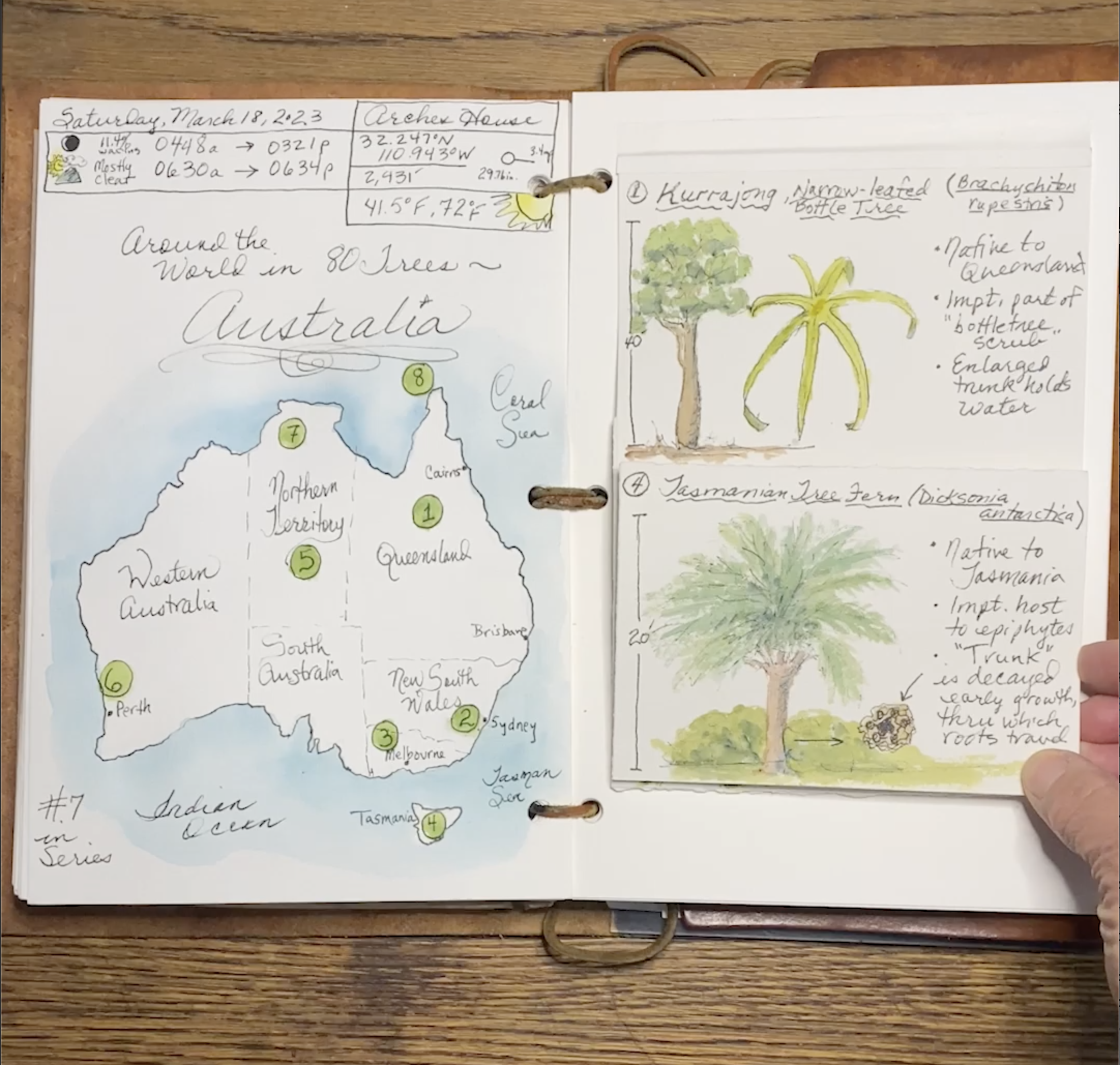Field Arts Workshop: Around the World in 80 Rocks, Fossils, and Formations No. 2 – North America (Pt. 2)
Note: you may turn on closed captions by clicking the “CC” button in the video controls. You can also view full screen by clicking the Expand arrows.
Based on my series Around the World in 80 Trees (in which we spent a year traveling around the globe by region and sketching interesting, weird, iconic, or beautiful trees and tree-like plants), this is a new series based on geology—we’ll travel the world and learn as much natural history as we can, plus master the art of quickly sketching rocks, fossils, and formations!
No. 1: North America (Part 1)
What you’ll need: a multi-media sketchbook or an accordion style booklet (see below), pen and / or pencil for our base drawings, and then watercolor or colored pencil to quickly bring them to life.
TIP: For plants I used a strip of heavy watercolor paper folded into four squares to create an “accordion” booklet to record my trees (8 total, 4 on each side).
Prepwork: I like to put a map on the first journal page showing where the specimen types were located—so find a good outline map of North America that takes in Alaska to Mexico.
Length: 2 hours
Downloads and Resources
Colors and brush I use:
I favor a simple primary “triad” plus two extra colors: Manganese Blue (“cyan”), Quinacridone Rose (“magenta”), Aureolin Yellow (“yellow”), and Burnt Sienna and Indanthrone Blue, all Daniel Smith.
I use an Isabey Squirrel Mop Travel Brush or a Pentel Waterbrush, depending on my mood!
Any amount is appreciated!
ROSEANN’S FINISHED PAGES
ATTENDEES’ Pages from the Workshop
Please post your pages on our Field Arts Community Forum! It’s free and easy to register, and private!
Field Arts Workshop: Around the World in 80 Rocks, Fossils, and Formations No. 1 – North America (Pt. 1)
Note: you may turn on closed captions by clicking the “CC” button in the video controls. You can also view full screen by clicking the Expand arrows.
Based on my series Around the World in 80 Trees (in which we spent a year traveling around the globe by region and sketching interesting, weird, iconic, or beautiful trees and tree-like plants), this is a new series based on geology—we’ll travel the world and learn as much natural history as we can, plus master the art of quickly sketching rocks, fossils, and formations!
No. 1: North America (Part 1)
What you’ll need: a multi-media sketchbook or an accordion style booklet (see below), pen and / or pencil for our base drawings, and then watercolor or colored pencil to quickly bring them to life.
TIP: For plants I used a strip of heavy watercolor paper folded into four squares to create an “accordion” booklet to record my trees (8 total, 4 on each side).
Prepwork: I like to put a map on the first journal page showing where the specimen types were located—so find a good outline map of North America that takes in Alaska to Mexico.
Length: 2 hours
Downloads and Resources
Colors and brush I use:
I favor a simple primary “triad” plus two extra colors: Manganese Blue (“cyan”), Quinacridone Rose (“magenta”), Aureolin Yellow (“yellow”), and Burnt Sienna and Indanthrone Blue, all Daniel Smith.
I use an Isabey Squirrel Mop Travel Brush or a Pentel Waterbrush, depending on my mood!
Any amount is appreciated!
ROSEANN’S FINISHED PAGES
ATTENDEES’ Pages from the Workshop
Please post your pages on our Field Arts Community Forum! It’s free and easy to register, and private!
How to Add Ephemera to Your Journal
How do you incorporate ephemera (maps, postcards, stamps, etc.) into your journal if you didn’t plan room for them, but you want to be sure you keep them secured for future access? 🗺🖼📑
I thought about stitching a pocket (made from a scrap of watercolor paper) onto one of the pages from Point Reyes, CA, but that would permanently cover part of my entry. Instead, I opted for insets, so the ephemera are removable yet secured while in the journal. Here’s the quick how-to:
Decide where you want the ephemera, then mark three corners with pencil (check the backside so you aren’t cutting across something you really like!).
I keep a small scalpel in my field bag, and a scrap of cardboard in the back of my journal. Slice across the diagonal on three corners, placing the cardboard underneath before you do so (don’t get too excited and forget!).
Slide in your ephemera and admire!







Field Arts Workshop: Around the World in 80 Animals No. 10 – Wild Cards!
Note: you may turn on closed captions by clicking the “CC” button in the video controls. You can also view full screen by clicking the Expand arrows.
Based on my series Around the World in 80 Trees (in which we spent a year traveling around the globe by region and sketching interesting, weird, iconic, or beautiful trees and tree-like plants), this is a new series based on animals—we’ll travel the world and learn as much natural history as we can, plus master the art of quickly sketching birds, mammals, monotremes, and more!
No. 10: Wild Cards!
What you’ll need: a multi-media sketchbook or an accordion style booklet (see below), pen and / or pencil for our base drawings, and then watercolor or colored pencil to quickly bring them to life.
TIP: For plants I used a strip of heavy watercolor paper folded into four squares to create an “accordion” booklet to record my trees (8 total, 4 on each side). For animals I recommend a full sketchbook, or larger squares, at least 5” if you choose an accordion.
Prepwork: One of the critters might do best on toned or black paper with white gel pen, white charcoal, or white gouache for sketching. I used a small square of black paper and glued it into my journal.
Length: 2 hours
Downloads and Resources
Colors and brush I use:
I favor a simple primary “triad” plus two extra colors: Manganese Blue (“cyan”), Quinacridone Rose (“magenta”), Aureolin Yellow (“yellow”), and Burnt Sienna and Indanthrone Blue, all Daniel Smith.
I use an Isabey Squirrel Mop Travel Brush or a Pentel Waterbrush, depending on my mood!
Any amount is appreciated!
ROSEANN’S FINISHED PAGES
ATTENDEES’ Pages from the Workshop
Please post your pages on our Field Arts Community Forum! It’s free and easy to register, and private!
Field Arts Workshop: Around the World in 80 Animals No. 9 – Oceania
Note: you may turn on closed captions by clicking the “CC” button in the video controls. You can also view full screen by clicking the Expand arrows.
Based on my series Around the World in 80 Trees (in which we spent a year traveling around the globe by region and sketching interesting, weird, iconic, or beautiful trees and tree-like plants), this is a new series based on animals—we’ll travel the world and learn as much natural history as we can, plus master the art of quickly sketching birds, mammals, monotremes, and more!
No. 9: Oceania
What you’ll need: a multi-media sketchbook or an accordion style booklet (see below), pen and / or pencil for our base drawings, and then watercolor or colored pencil to quickly bring them to life.
TIP: For plants I used a strip of heavy watercolor paper folded into four squares to create an “accordion” booklet to record my trees (8 total, 4 on each side). For animals I recommend a full sketchbook, or larger squares, at least 5” if you choose an accordion.
Prepwork: Create a map of the region so you can place the regions the species were located. Longtime “Around the World” series attendee Dorothea suggested this one (just be sure to acknowledge the source on your sketch): Simple Outline Oceania Map
Length: 2 hours
Downloads and Resources
PDF of the Presentation
Because I had so much trouble with the internet, I had to turn on the “talking head” box, and this showed up at times covering the titles on the slides, so here is a link to view the PDF of the slide show for detail. Please note this is for personal use only, and may not be used for any presentations or workshops without written permission.
Colors and brush I use:
I favor a simple primary “triad” plus two extra colors: Manganese Blue (“cyan”), Quinacridone Rose (“magenta”), Aureolin Yellow (“yellow”), and Burnt Sienna and Indanthrone Blue, all Daniel Smith.
I use an Isabey Squirrel Mop Travel Brush or a Pentel Waterbrush, depending on my mood!
Any amount is appreciated!
ROSEANN’S FINISHED PAGES
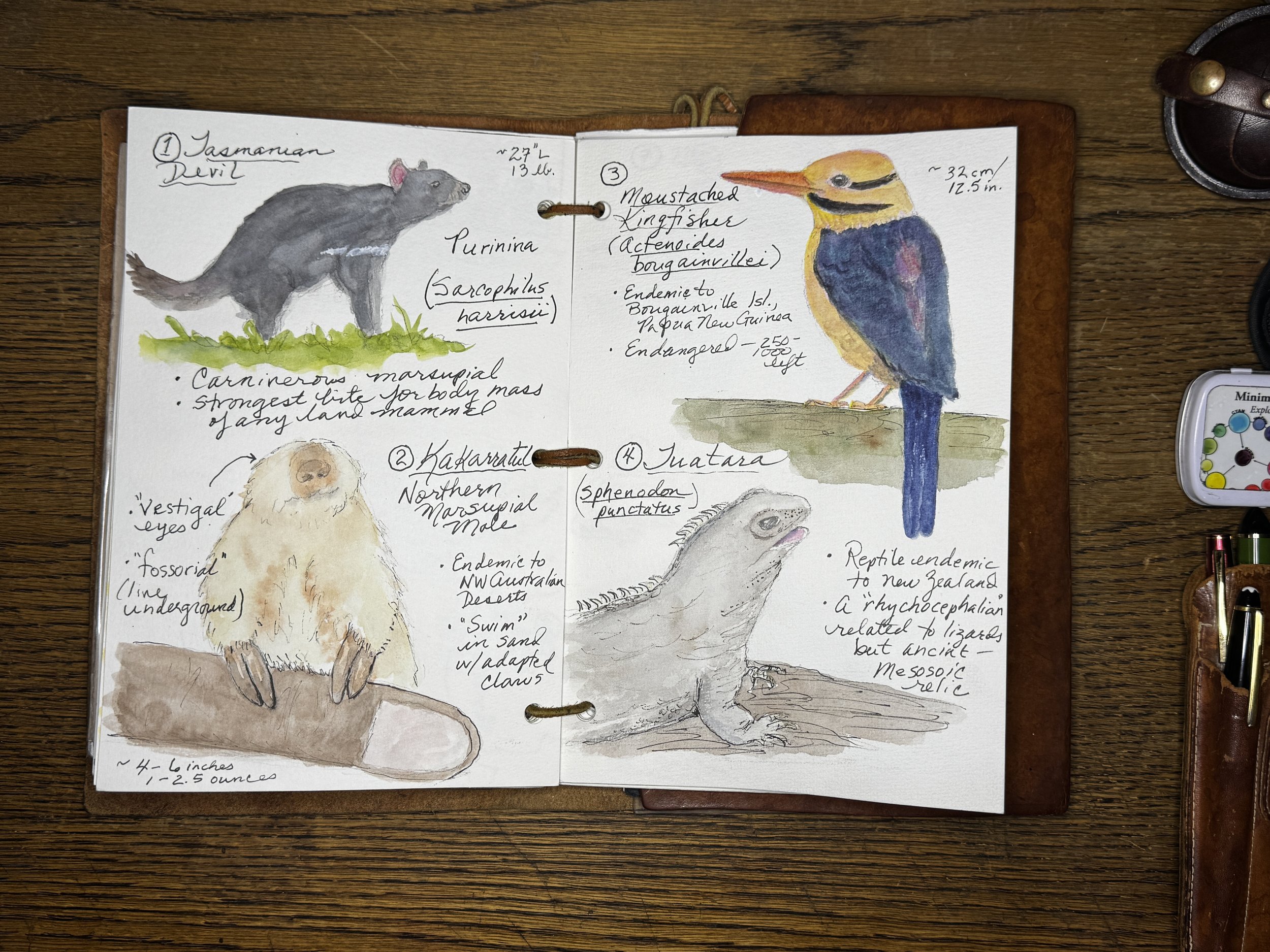
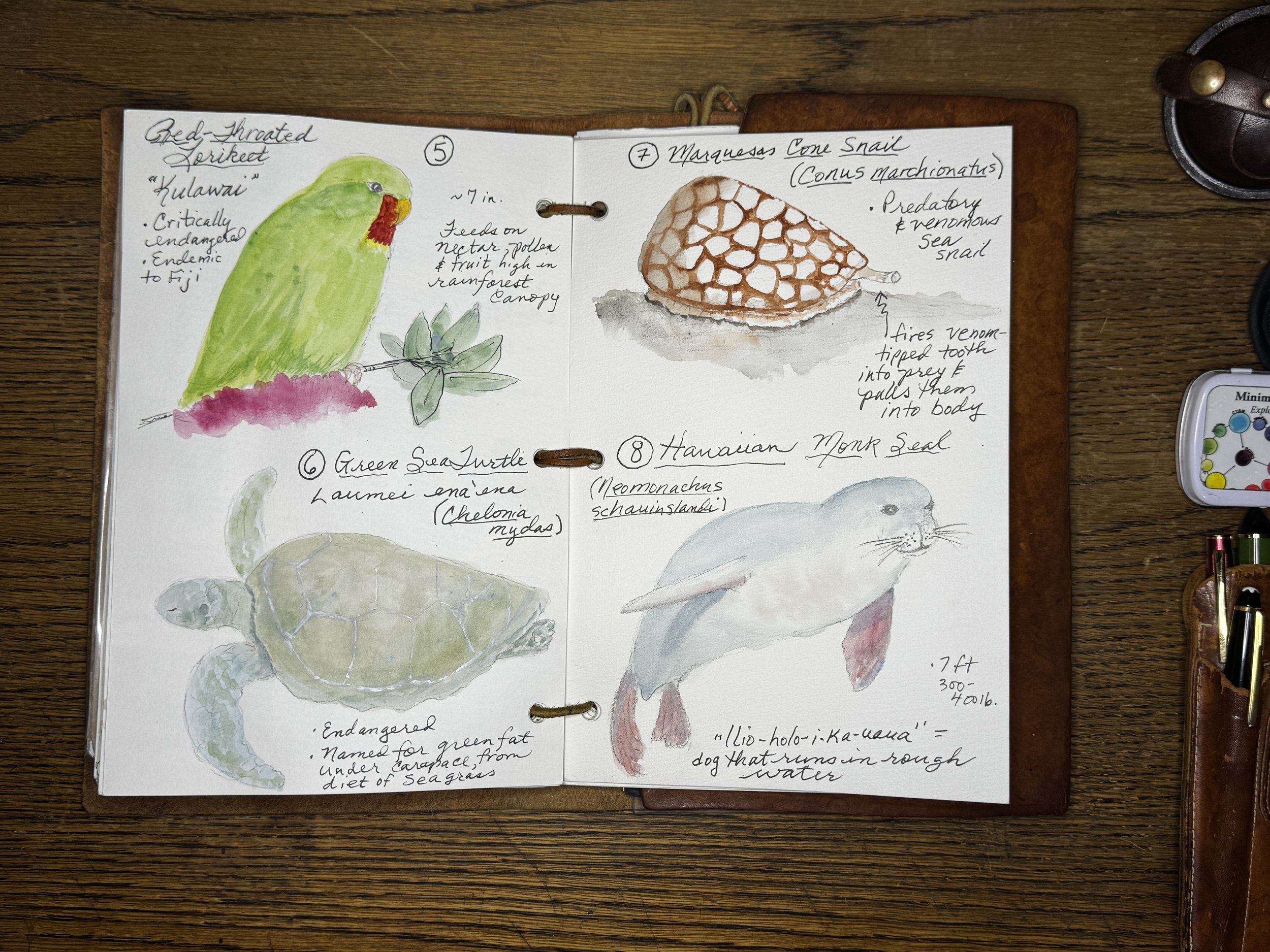
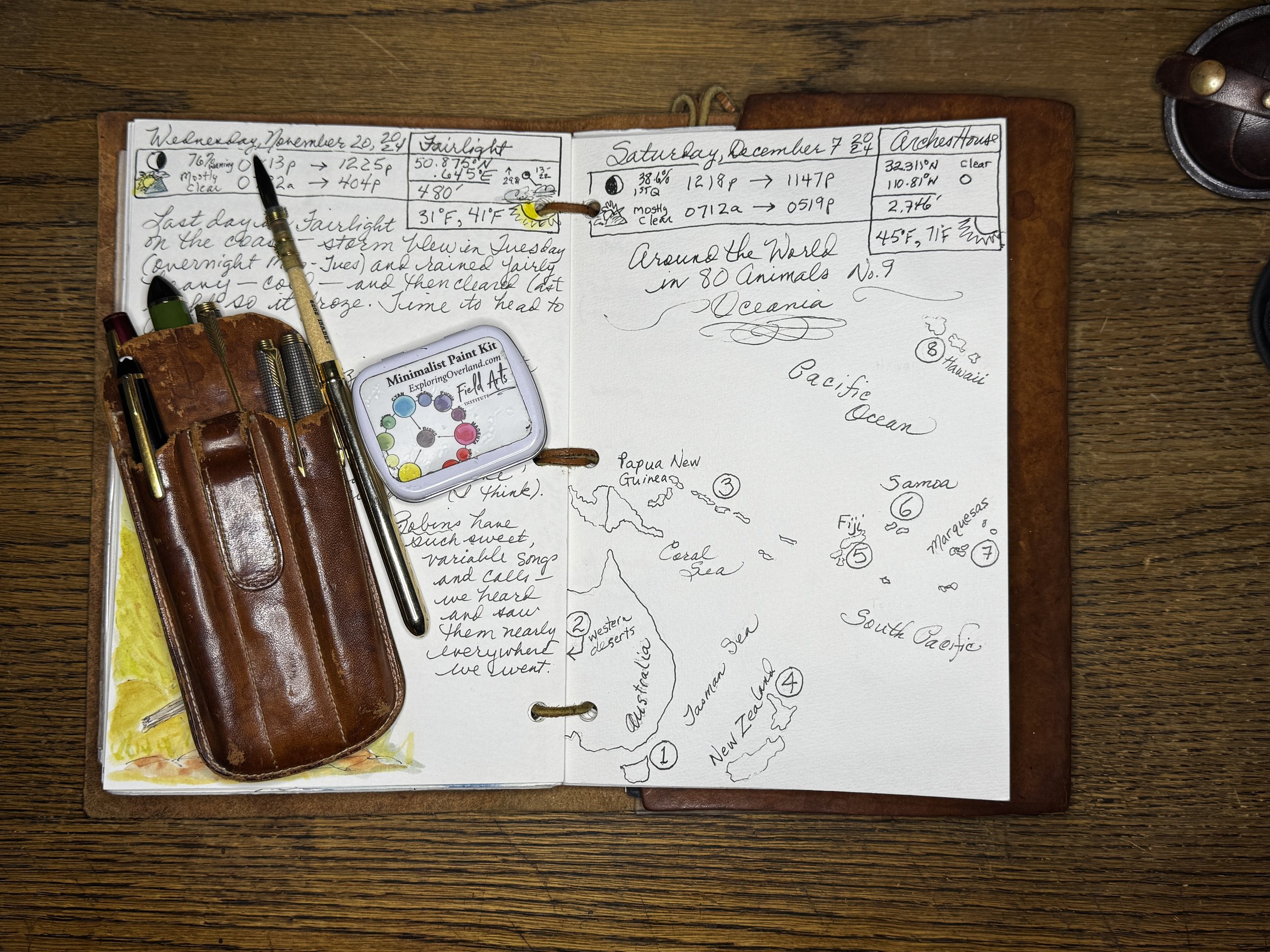
ATTENDEES’ Pages from the Workshop
Please post your pages on our Field Arts Community Forum! It’s free and easy to register, and private!
Field Arts Workshop: Around the World in 80 Animals No. 8 (East and South Asia)
Note: you may turn on closed captions by clicking the “CC” button in the video controls. You can also view full screen by clicking the Expand arrows.
Draco_spilonotus By A.S.Kono - Own work, CC BY-SA 3.0
Based on my series Around the World in 80 Trees (in which we spent a year traveling around the globe by region and sketching interesting, weird, iconic, or beautiful trees and tree-like plants), this is a new series based on animals—we’ll travel the world and learn as much natural history as we can, plus master the art of quickly sketching birds, mammals, monotremes, and more!
No. 8: Eastern and South Asia
What you’ll need: a multi-media sketchbook or an accordion style booklet (see below), pen and / or pencil for our base drawings, and then watercolor or colored pencil to quickly bring them to life.
TIP: For plants I used a strip of heavy watercolor paper folded into four squares to create an “accordion” booklet to record my trees (8 total, 4 on each side). For animals I recommend a full sketchbook, or larger squares, at least 5” if you choose an accordion.
Prepwork: Create a map of the region so you can place the regions the species were located.
Length: 2 hours
Downloads and Resources
Colors and brush I use:
I favor a simple primary “triad” plus two extra colors: Manganese Blue (“cyan”), Quinacridone Rose (“magenta”), Aureolin Yellow (“yellow”), and Burnt Sienna and Indanthrone Blue, all Daniel Smith.
I use an Isabey Squirrel Mop Travel Brush or a Pentel Waterbrush, depending on my mood!
Any amount is appreciated!
ROSEANN’S FINISHED PAGES
ATTENDEES’ Pages from the Workshop
Please post your pages on our Field Arts Community Forum! It’s free and easy to register, and private!
Field Arts Workshop: Around the World in 80 Animals No. 7 (Middle East and W. Asia)
Note: you may turn on closed captions by clicking the “CC” button in the video controls. You can also view full screen by clicking the Expand arrows.
Nubian ibex by Netzach Farbiash, Ph.D Pikiwiki Israel, CC BY 2.5 Wikipedia
Golden hamster By Harpoen - Own work, CC BY-SA 3.0
Based on my series Around the World in 80 Trees (in which we spent a year traveling around the globe by region and sketching interesting, weird, iconic, or beautiful trees and tree-like plants), this is a new series based on animals—we’ll travel the world and learn as much natural history as we can, plus master the art of quickly sketching birds, mammals, monotremes, and more!
No. 7: Middle East and Western Asia
What you’ll need: a multi-media sketchbook or an accordion style booklet (see below), pen and / or pencil for our base drawings, and then watercolor or colored pencil to quickly bring them to life.
TIP: For plants I used a strip of heavy watercolor paper folded into four squares to create an “accordion” booklet to record my trees (8 total, 4 on each side). For animals I recommend a full sketchbook, or larger squares, at least 5” if you choose an accordion.
Prepwork: Create a map of the region so you can place the regions the species were located.
Length: 2 hours
Downloads and Resources
Colors and brush I use:
I favor a simple primary “triad” plus two extra colors: Manganese Blue (“cyan”), Quinacridone Rose (“magenta”), Aureolin Yellow (“yellow”), and Burnt Sienna and Indanthrone Blue, all Daniel Smith.
I use an Isabey Squirrel Mop Travel Brush.
Any amount is appreciated!
ROSEANN’S FINISHED PAGES
ATTENDEES’ Pages from the Workshop
Please post your pages on our Field Arts Community Forum! It’s free and easy to register, and private!
Field Arts Workshop: Around the World in 80 Animals No. 6 (Europe)
Note: you may turn on closed captions by clicking the “CC” button in the video controls. You can also view full screen by clicking the Expand arrows.
Iberian wolf (by Arturo de Frias Marques - Own work, CC BY-SA 4.0, https://commons.wikimedia.org/w/index.php?curid=36546315)
Eurasian red squirrel (by hedera.baltica from Wrocław, Poland - Squirrel, CC BY-SA 2.0, https://commons.wikimedia.org/w/index.php?curid=43379772 )
Based on my series Around the World in 80 Trees (in which we spent a year traveling around the globe by region and sketching interesting, weird, iconic, or beautiful trees and tree-like plants), this is a new series based on animals—we’ll travel the world and learn as much natural history as we can, plus master the art of quickly sketching birds, mammals, monotremes, and more!
No. 6: Europe
What you’ll need: a multi-media sketchbook or an accordion style booklet (see below), pen and / or pencil for our base drawings, and then watercolor or colored pencil to quickly bring them to life.
TIP: For plants I used a strip of heavy watercolor paper folded into four squares to create an “accordion” booklet to record my trees (8 total, 4 on each side). For animals I recommend a full sketchbook, or larger squares, at least 5” if you choose an accordion.
Prepwork: Create a map of the region so you can place the regions the species were located.
Length: 2 hours
Downloads and Resources
Colors and brush I use:
I favor a simple primary “triad” plus two extra colors: Manganese Blue (“cyan”), Quinacridone Rose (“magenta”), Aureolin Yellow (“yellow”), and Burnt Sienna and Indanthrone Blue, all Daniel Smith.
I use an Isabey Squirrel Mop Travel Brush.
Any amount is appreciated!
ROSEANN’S FINISHED PAGE
ATTENDEES’ Pages from the Workshop
Please post your pages on our Field Arts Community Forum! It’s free and easy to register, and private!
Field Arts Workshop: Around the World in 80 Animals No. 5 (Africa, Pt. 2)
Note: you may turn on closed captions by clicking the “CC” button in the video controls. You can also view full screen by clicking the Expand arrows.
By Olaf Oliviero Riemer, CC BY-SA 3.0, https://commons.wikimedia.org/w/index.php?curid=18375332
naturepl.com / : Daniel Heuclin Media ID 20783286 © www.naturepl.com https://www.natureplprints.com/april-2021-highlights/sahara-sand-viper-cerastes-vipera-20783286.html
Based on my series Around the World in 80 Trees (in which we spent a year traveling around the globe by region and sketching interesting, weird, iconic, or beautiful trees and tree-like plants), this is a new series based on animals—we’ll travel the world and learn as much natural history as we can, plus master the art of quickly sketching birds, mammals, monotremes, and more!
No. 4: Africa (Part 1)
What you’ll need: a multi-media sketchbook or an accordion style booklet (see below), pen and / or pencil for our base drawings, and then watercolor or colored pencil to quickly bring them to life.
TIP: For plants I used a strip of heavy watercolor paper folded into four squares to create an “accordion” booklet to record my trees (8 total, 4 on each side). For animals I recommend a full sketchbook, or larger squares, at least 5” if you choose an accordion.
Prepwork: Create a map of the region so you can place the regions the species were located.
Length: 2 hours
Downloads and Resources
Colors and brush I use:
I favor a simple primary “triad” plus two extra colors: Manganese Blue (“cyan”), Quinacridone Rose (“magenta”), Aureolin Yellow (“yellow”), and Burnt Sienna and Indanthrone Blue, all Daniel Smith.
I use an Isabey Squirrel Mop Travel Brush.
Any amount is appreciated!
ROSEANN’S FINISHED PAGE
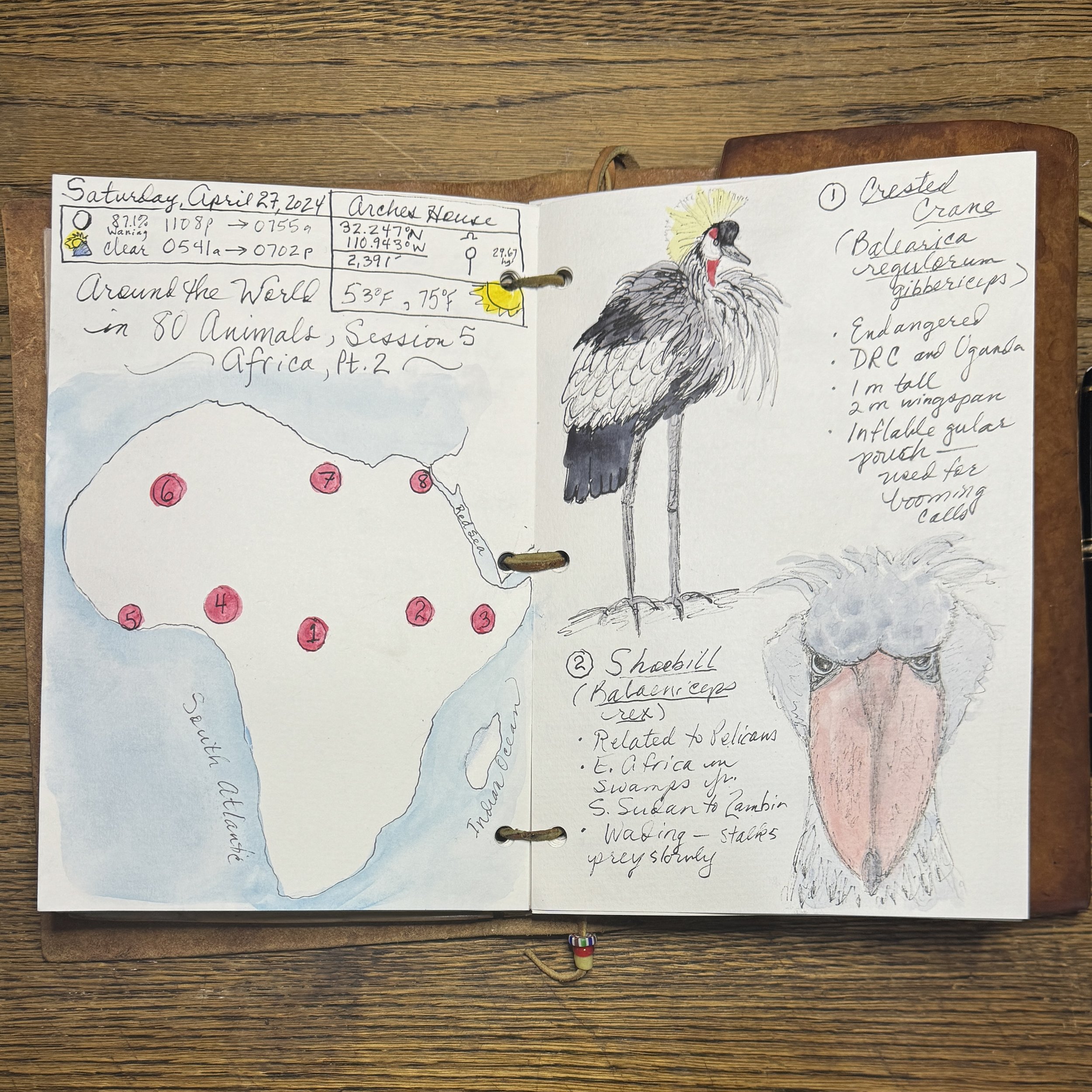


ATTENDEES’ Pages from the Workshop
Please post your pages on our Field Arts Community Forum! It’s free and easy to register, and private!

Field Arts Workshop: Around the World in 80 Animals No. 4 (Africa, Pt. 1)
Note: you may turn on closed captions by clicking the “CC” button in the video controls. You can also view full screen by clicking the Expand arrows.
Getty Images - Unsplash Plus.com
Based on my series Around the World in 80 Trees (in which we spent a year traveling around the globe by region and sketching interesting, weird, iconic, or beautiful trees and tree-like plants), this is a new series based on animals—we’ll travel the world and learn as much natural history as we can, plus master the art of quickly sketching birds, mammals, monotremes, and more!
No. 4: Africa (Part 1)
What you’ll need: a multi-media sketchbook or an accordion style booklet (see below), pen and / or pencil for our base drawings, and then watercolor or colored pencil to quickly bring them to life.
TIP: For plants I used a strip of heavy watercolor paper folded into four squares to create an “accordion” booklet to record my trees (8 total, 4 on each side). For animals I recommend a full sketchbook, or larger squares, at least 5” if you choose an accordion.
Prepwork: Create a map of the region so you can place the regions the species were located.
Length: 2 hours
Downloads and Resources
Colors and brush I use:
I favor a simple primary “triad” plus two extra colors: Manganese Blue (“cyan”), Quinacridone Rose (“magenta”), Aureolin Yellow (“yellow”), and Burnt Sienna and Indanthrone Blue, all Daniel Smith.
I use an Isabey Squirrel Mop Travel Brush.
Any amount is appreciated!
ROSEANN’S FINISHED PAGE
ATTENDEES’ Pages from the Workshop
Please post your pages on our Field Arts Community Forum! It’s free and easy to register, and private!
Field Arts Workshop: Around the World in 80 Animals No. 3 (South America)
Note: you may turn on closed captions by clicking the “CC” button in the video controls. You can also view full screen by clicking the Expand arrows.
Photo: Jonathan Hanson
Electrophorus_electricus_showing_lateral_line_pits By Oleksandr (Alex) Zakletsky - Own work, CC BY 4.0, Wikipedia
Based on my series Around the World in 80 Trees (in which we spent a year traveling around the globe by region and sketching interesting, weird, iconic, or beautiful trees and tree-like plants), this is a new series based on animals—we’ll travel the world and learn as much natural history as we can, plus master the art of quickly sketching birds, mammals, monotremes, and more!
No. 3: South America
What you’ll need: a multi-media sketchbook or an accordion style booklet (see below), pen and / or pencil for our base drawings, and then watercolor or colored pencil to quickly bring them to life.
TIP: For plants I used a strip of heavy watercolor paper folded into four squares to create an “accordion” booklet to record my trees (8 total, 4 on each side). For animals I recommend a full sketchbook, or larger squares, at least 5” if you choose an accordion.
Prepwork: Create a map of the region so you can place the regions the species were located.
Length: 2 hours, 17 minutes
Downloads and Resources
Colors and brush I use:
I favor a simple primary “triad” plus two extra colors: Manganese Blue (“cyan”), Quinacridone Rose (“magenta”), Aureolin Yellow (“yellow”), and Burnt Sienna and Indanthrone Blue, all Daniel Smith.
I use an Isabey Squirrel Mop Travel Brush.
Any amount is appreciated!
ROSEANN’S FINISHED PAGES
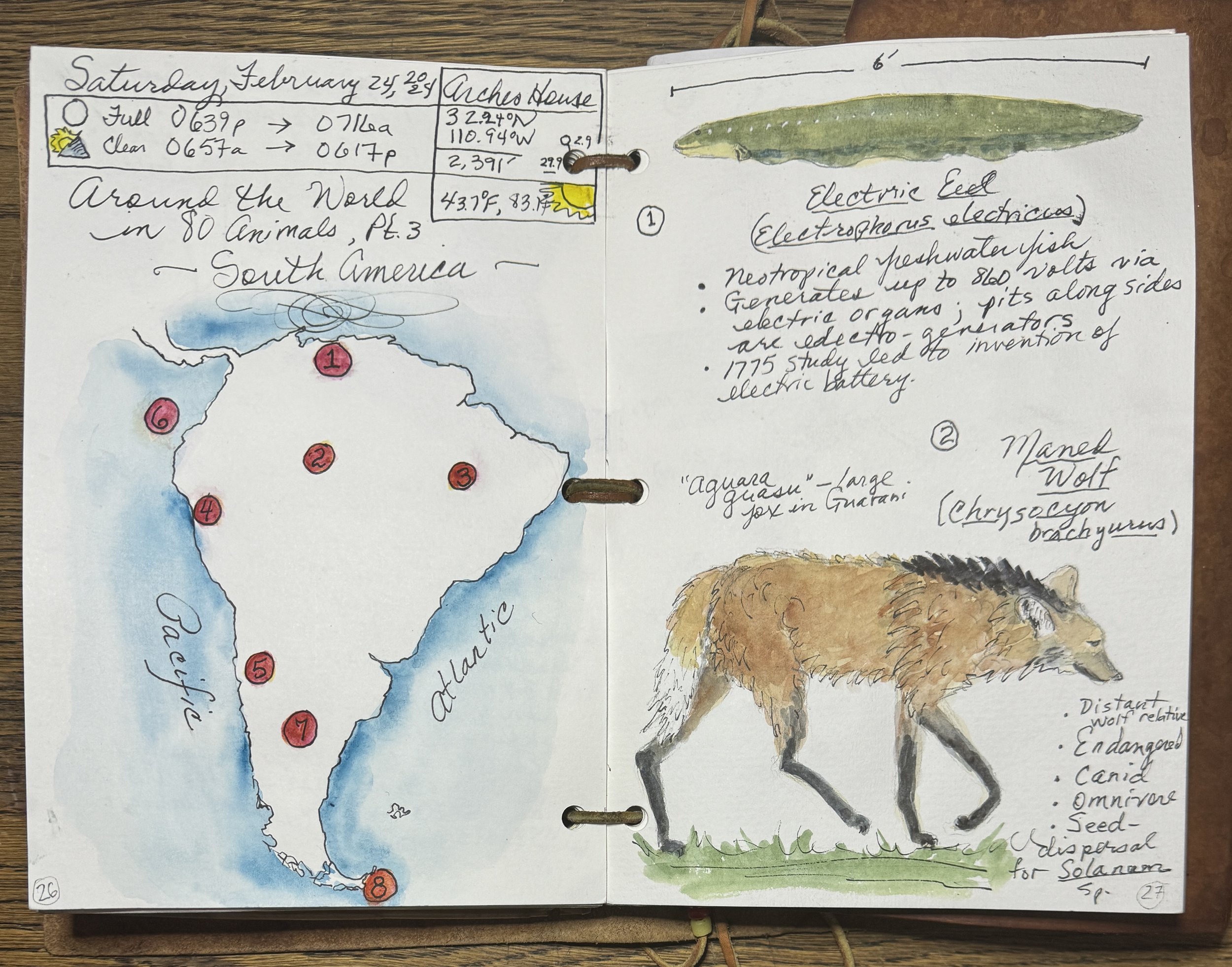


ATTENDEES’ Pages from the Workshop
Please post your pages on our Field Arts Community Forum! It’s free and easy to register, and private!
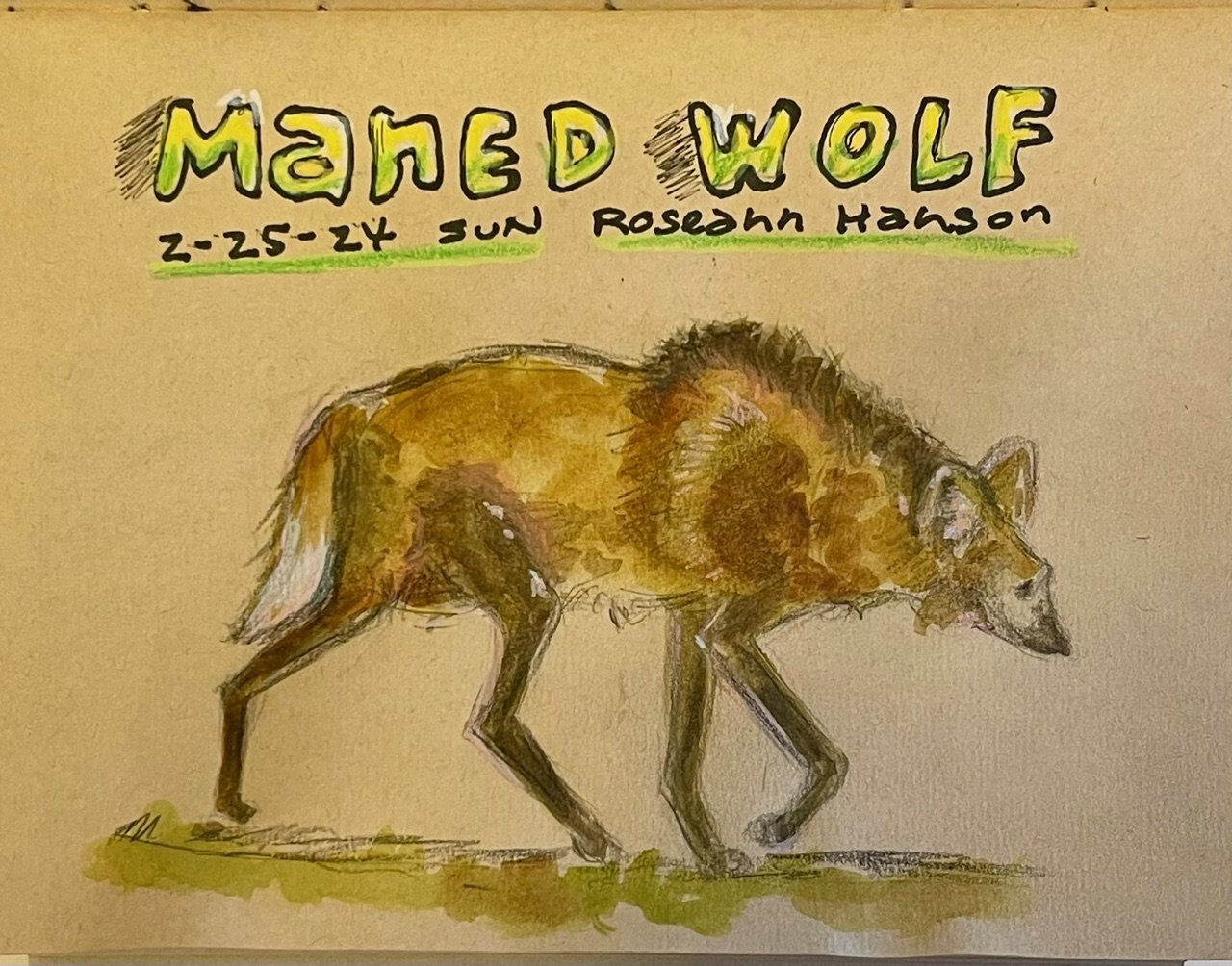
Field Arts Workshop: Around the World in 80 Animals No. 2 (North America Part 2)
Note: you may turn on closed captions by clicking the “CC” button in the video controls. You can also view full screen by clicking the Expand arrows.
Click on images for larger view.
Based on my series Around the World in 80 Trees (in which we spent a year traveling around the globe by region and sketching interesting, weird, iconic, or beautiful trees and tree-like plants), this is a new series based on animals—we’ll travel the world and learn as much natural history as we can, plus master the art of quickly sketching birds, mammals, monotremes, and more!
No. 2: North America, Part 2, the South
What you’ll need: a multi-media sketchbook or an accordion style booklet (see below), pen and / or pencil for our base drawings, and then watercolor or colored pencil to quickly bring them to life.
TIP: I used a strip of heavy watercolor paper folded into four squares to create an “accordion” booklet to record my trees (8 total, 4 on each side). For animals I recommend larger squares, at least 5” if you choose an accordion.
Prepwork: Create a map of the region so you can place the regions the species were located.
Length: 2 hours
Downloads and Resources
Colors and brush I use:
I favor a simple primary “triad” plus two extra colors: Manganese Blue (“cyan”), Quinacridone Rose (“magenta”), Aureolin Yellow (“yellow”), and Burnt Sienna and Indanthrone Blue, all Daniel Smith.
I use an Isabey Squirrel Mop Travel Brush.
Any amount is appreciated!
ROSEANN’S FINISHED PAGES
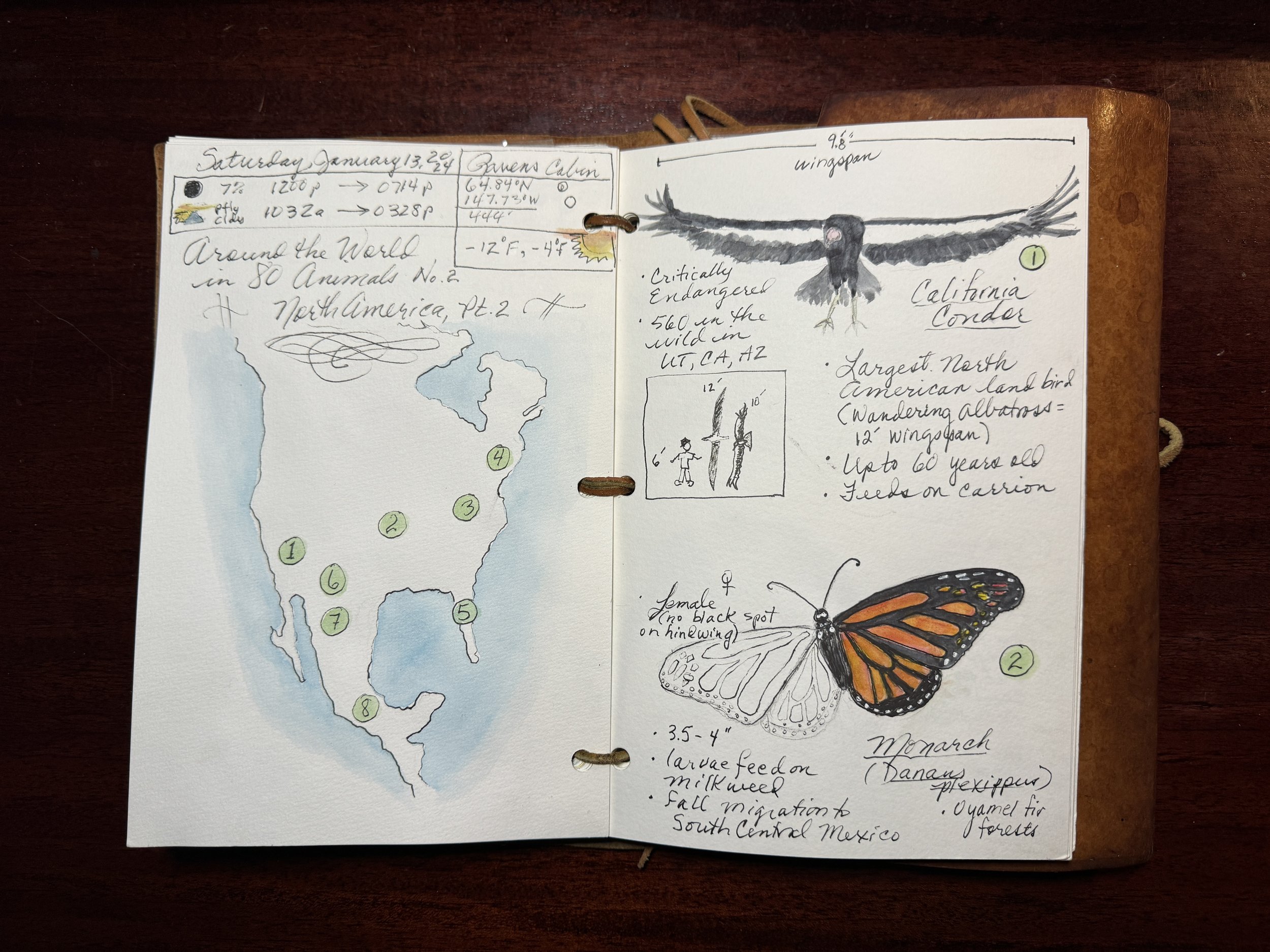
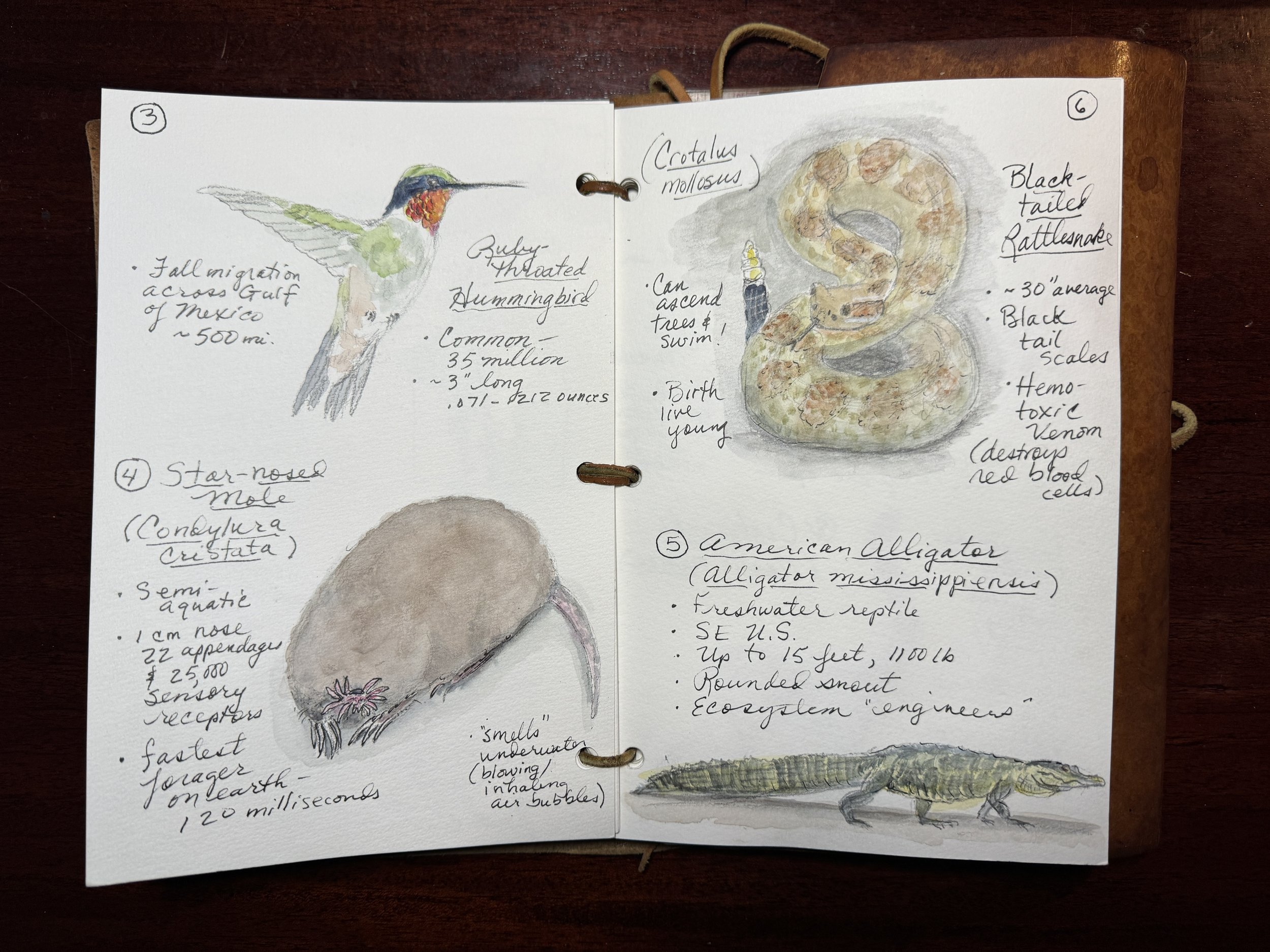
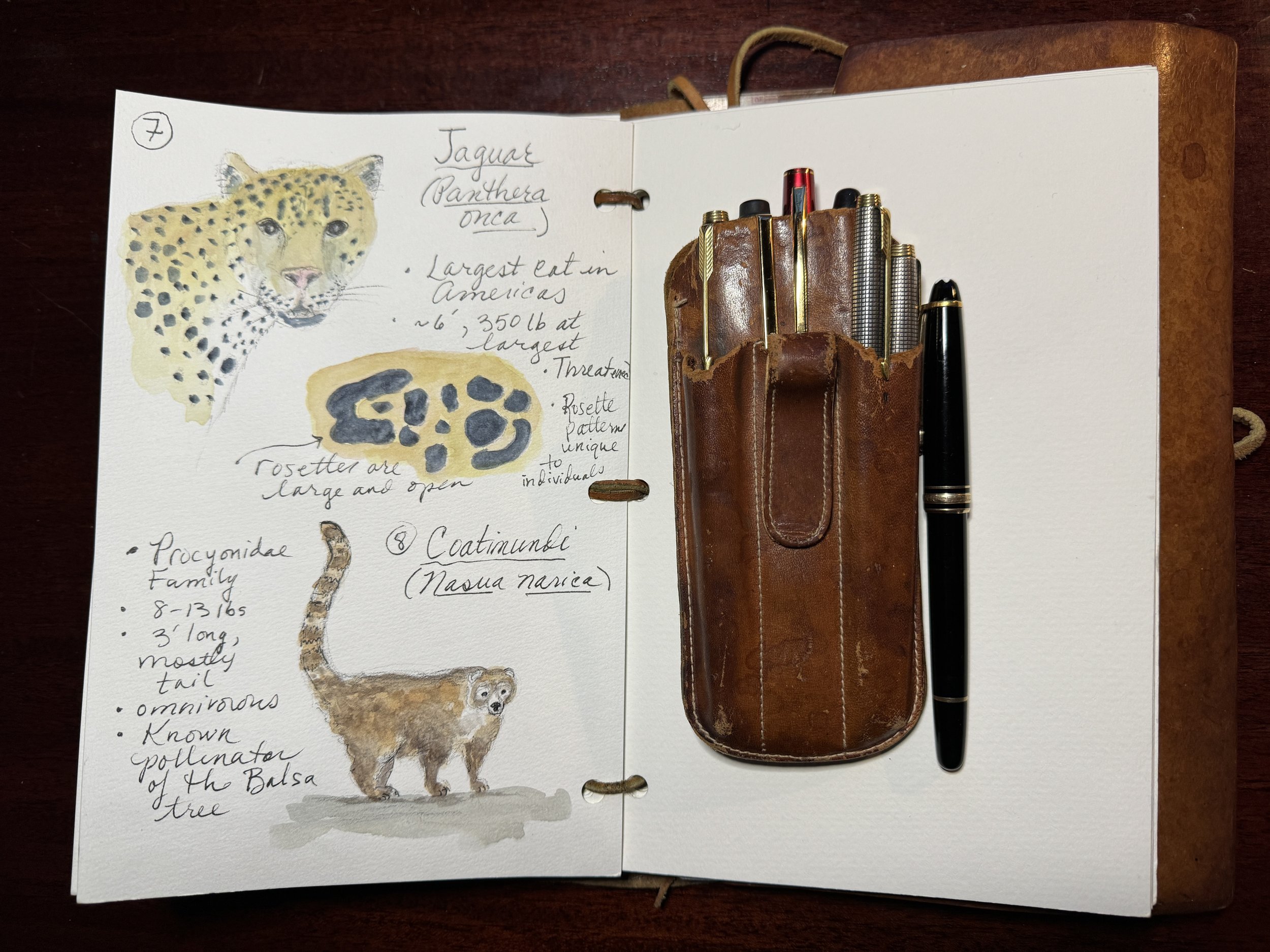
ATTENDEES’ Pages from the Workshop
Please post your pages on our Field Arts Community Forum! It’s free and easy to register, and private!
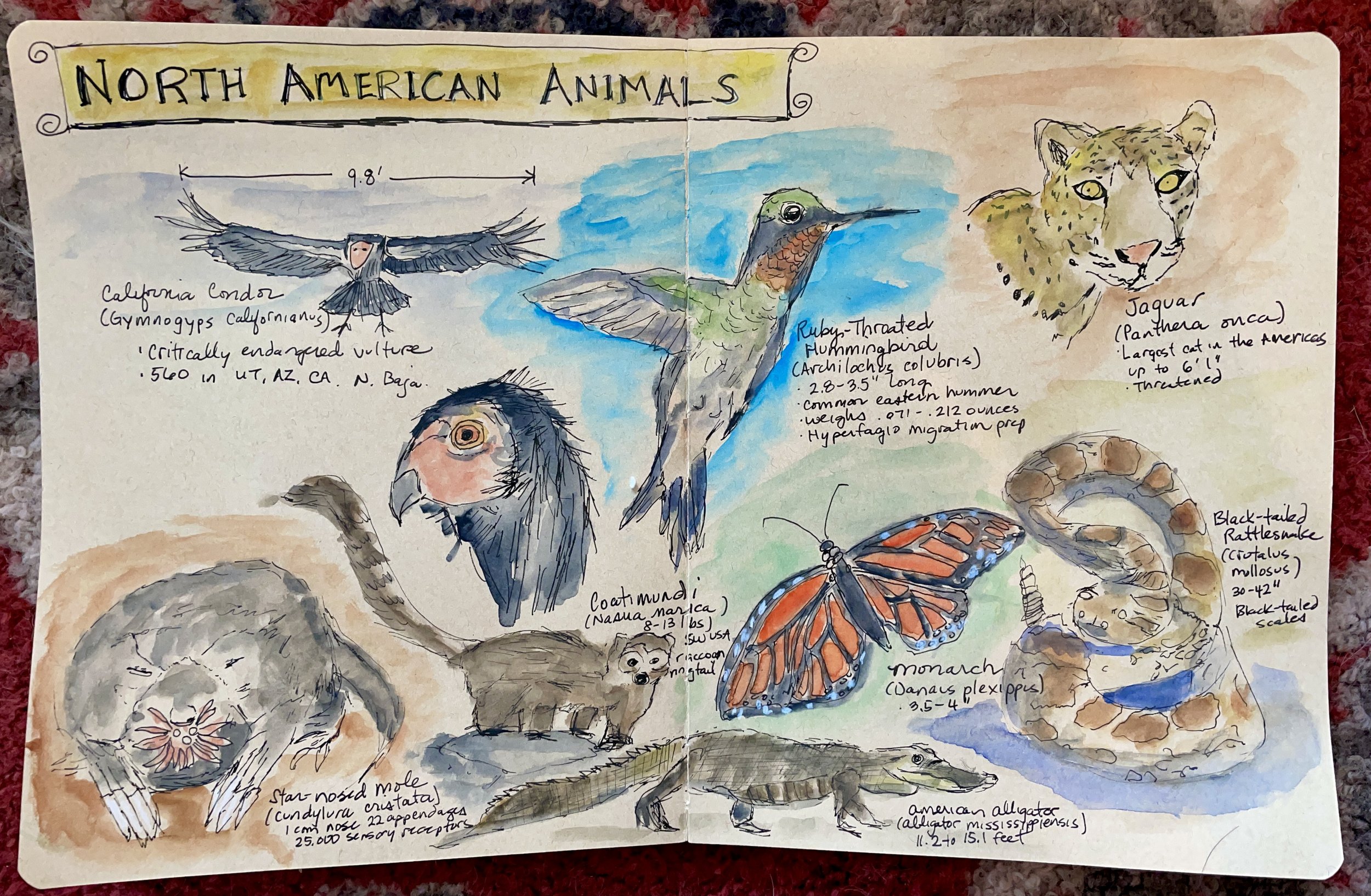
Field Arts Workshop: Around the World in 80 Animals No. 1 (North America Part 1)
Note: you may turn on closed captions by clicking the “CC” button in the video controls. You can also view full screen by clicking the Expand arrows.
Click on images for larger view.
Based on my series Around the World in 80 Trees (in which we spent a year traveling around the globe by region and sketching interesting, weird, iconic, or beautiful trees and tree-like plants), this is a new series based on animals—we’ll travel the world and learn as much natural history as we can, plus master the art of quickly sketching birds, mammals, monotremes, and more!
No. 1: North America, Part 1, the North
What you’ll need: a multi-media sketchbook or an accordion style booklet (see below), pen and / or pencil for our base drawings, and then watercolor or colored pencil to quickly bring them to life.
TIP: I used a strip of heavy watercolor paper folded into four squares to create an “accordion” booklet to record my trees (8 total, 4 on each side). For animals I recommend larger squares, at least 5” if you choose an accordion.
Prepwork: Create a map of the world so you can sketch location points for each species (North America, Pacific, Australia Europe).
Length: 2 hours
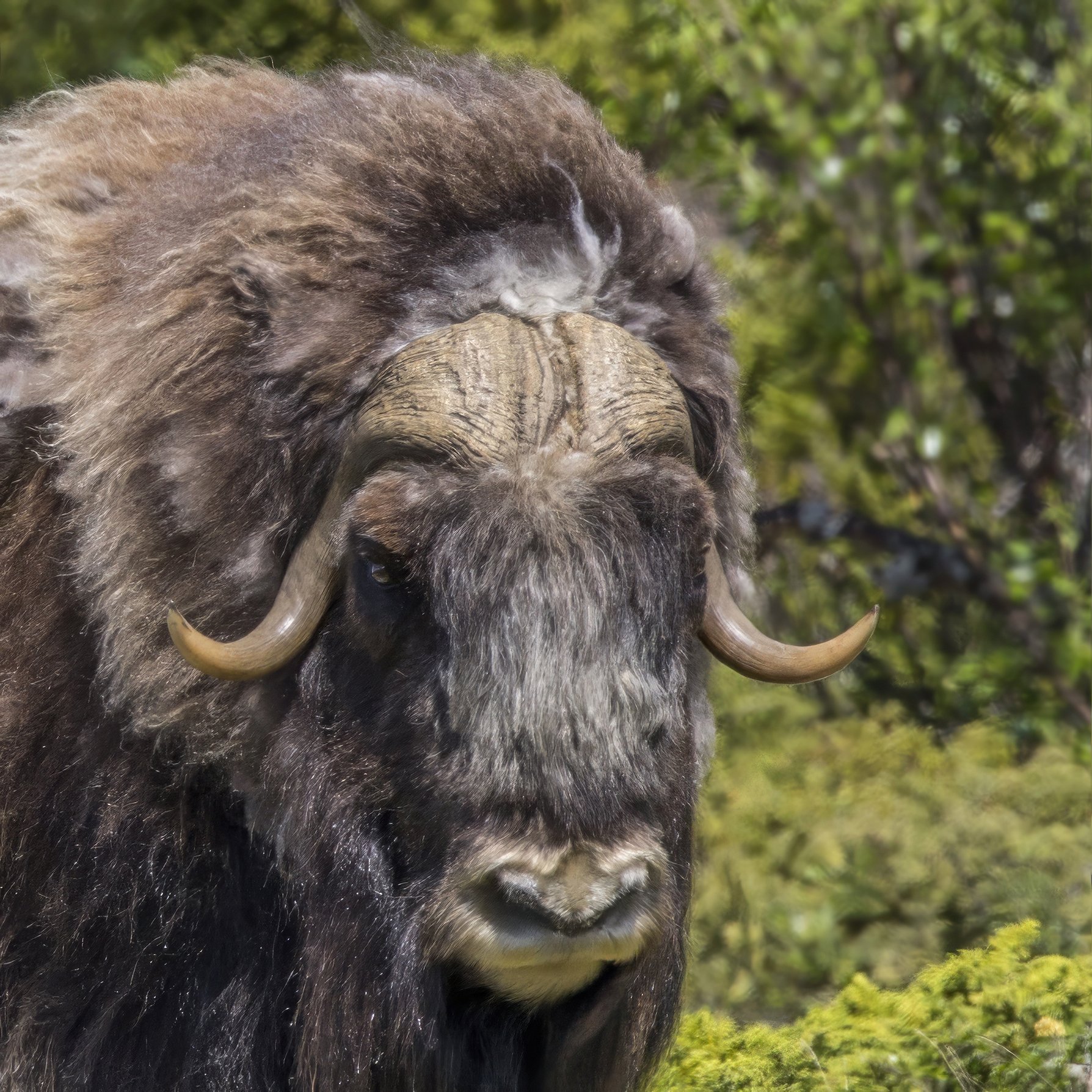
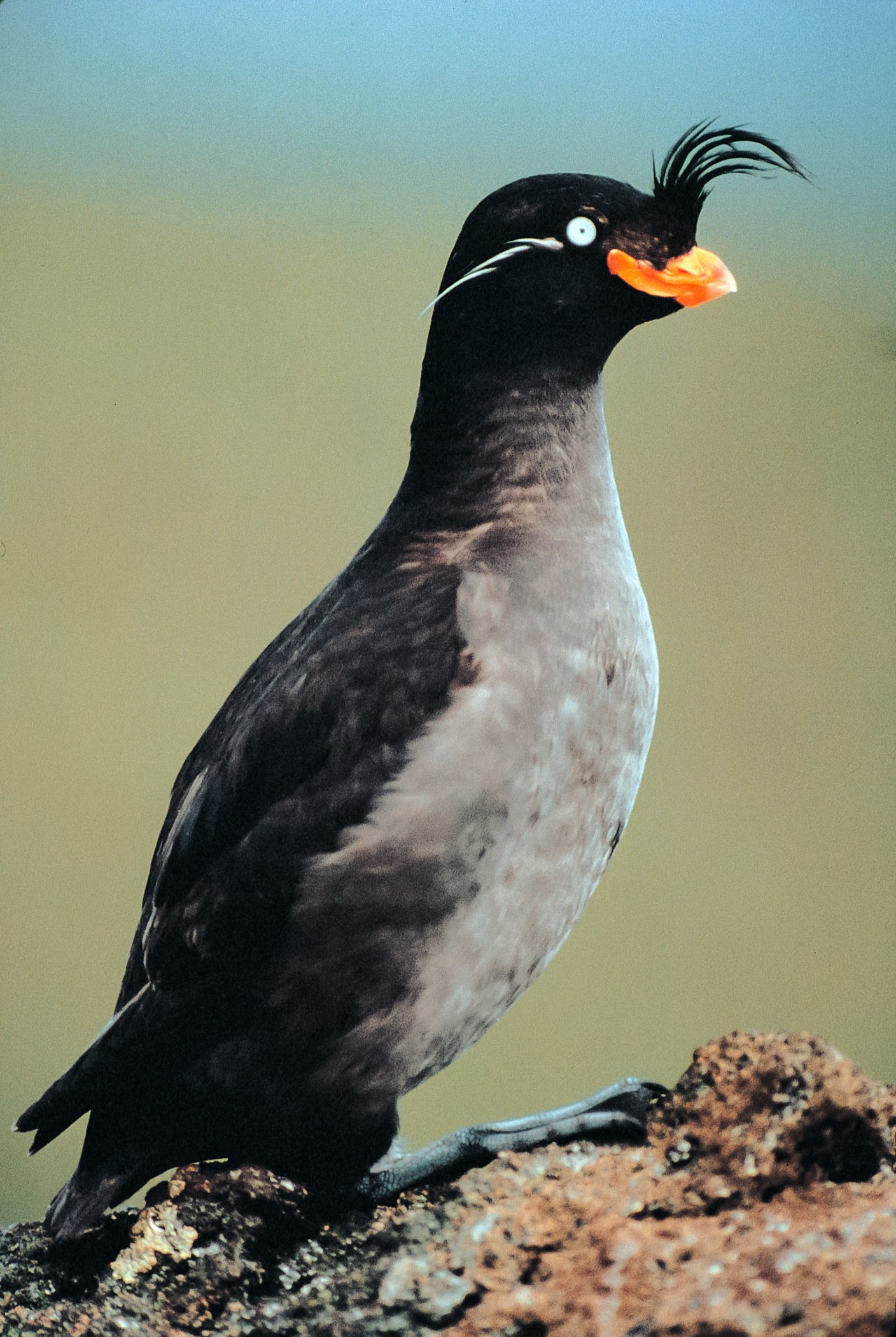
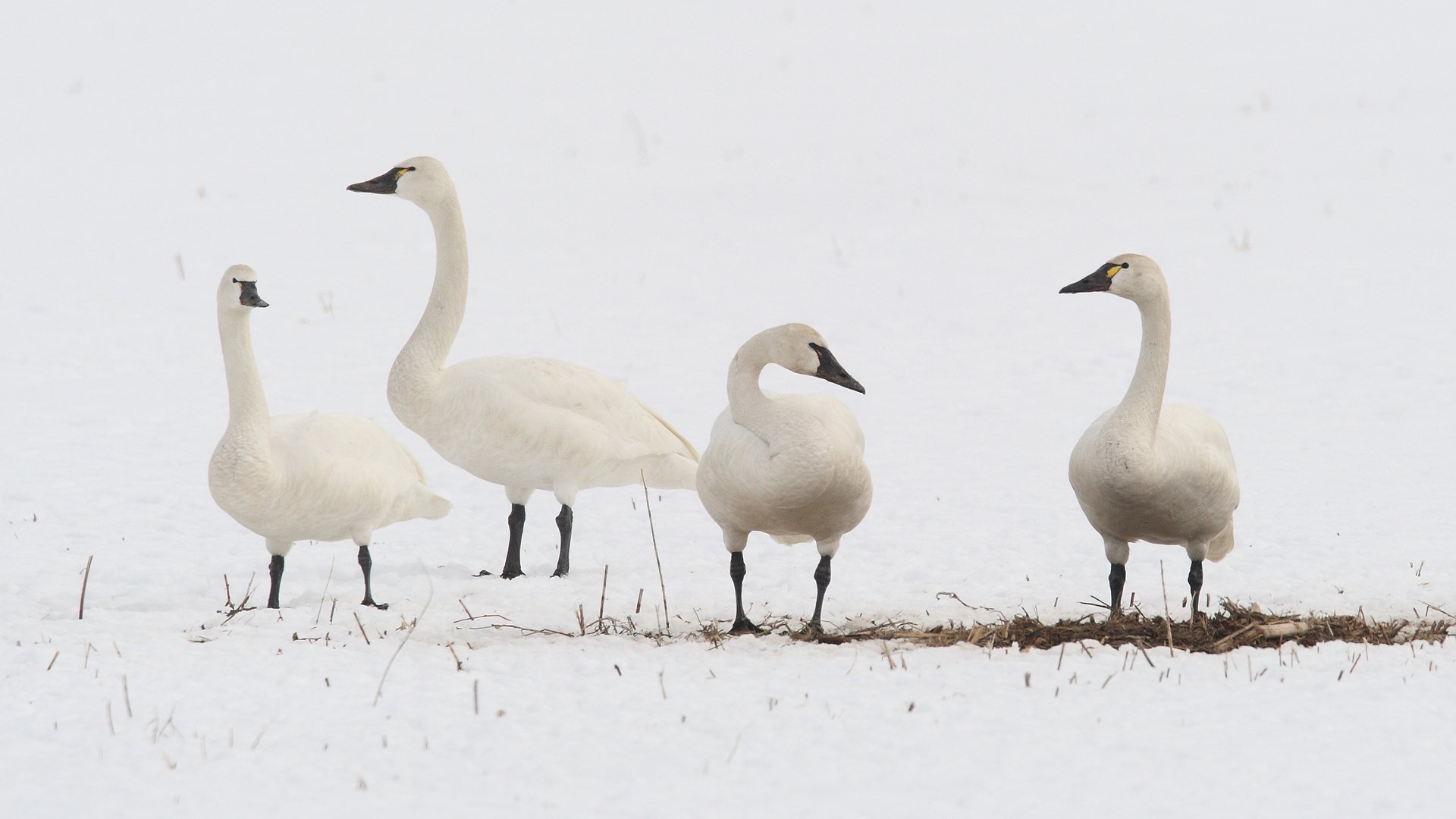
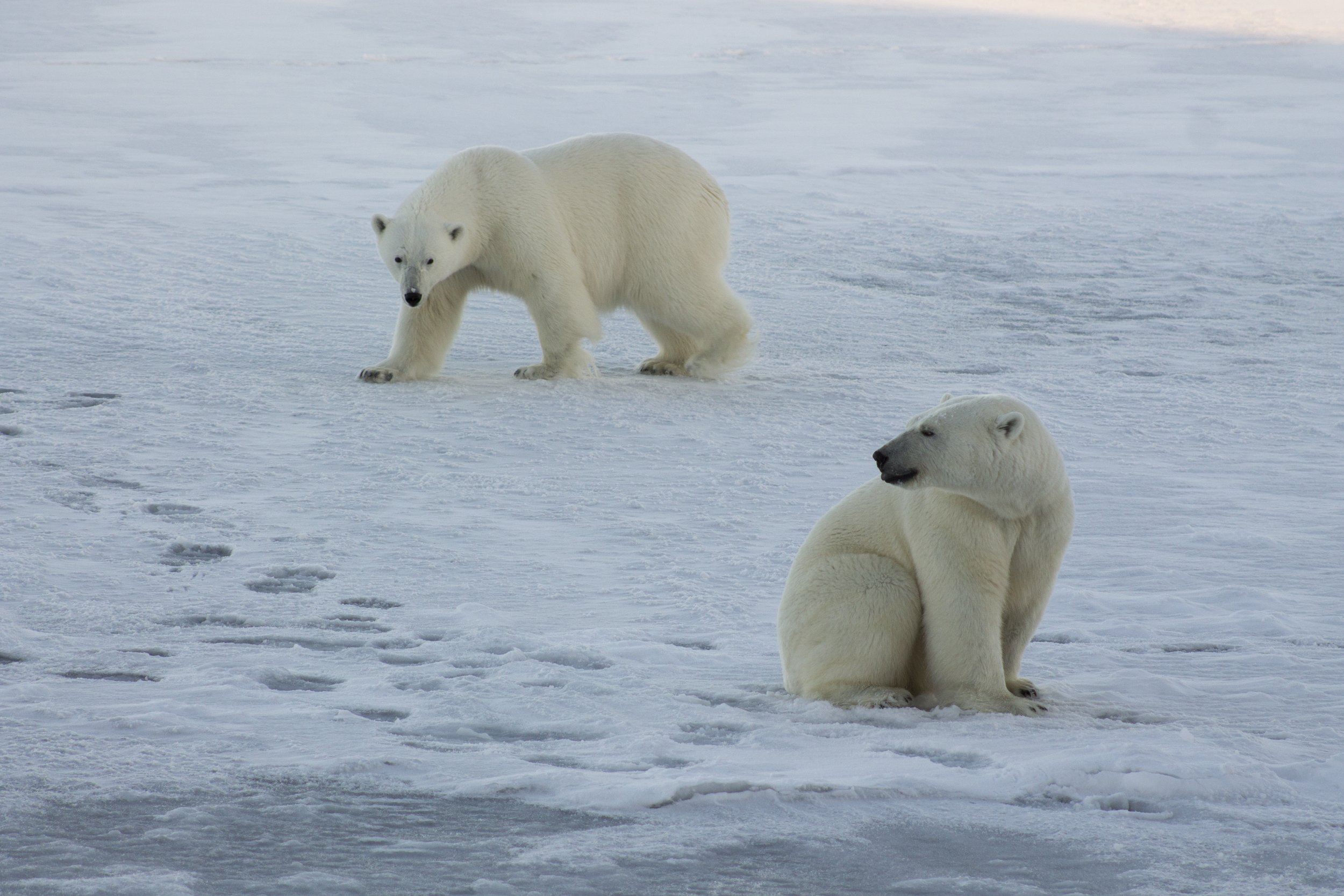
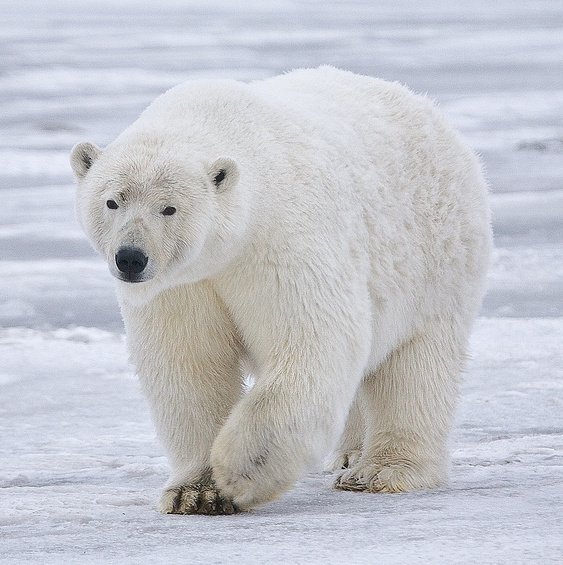
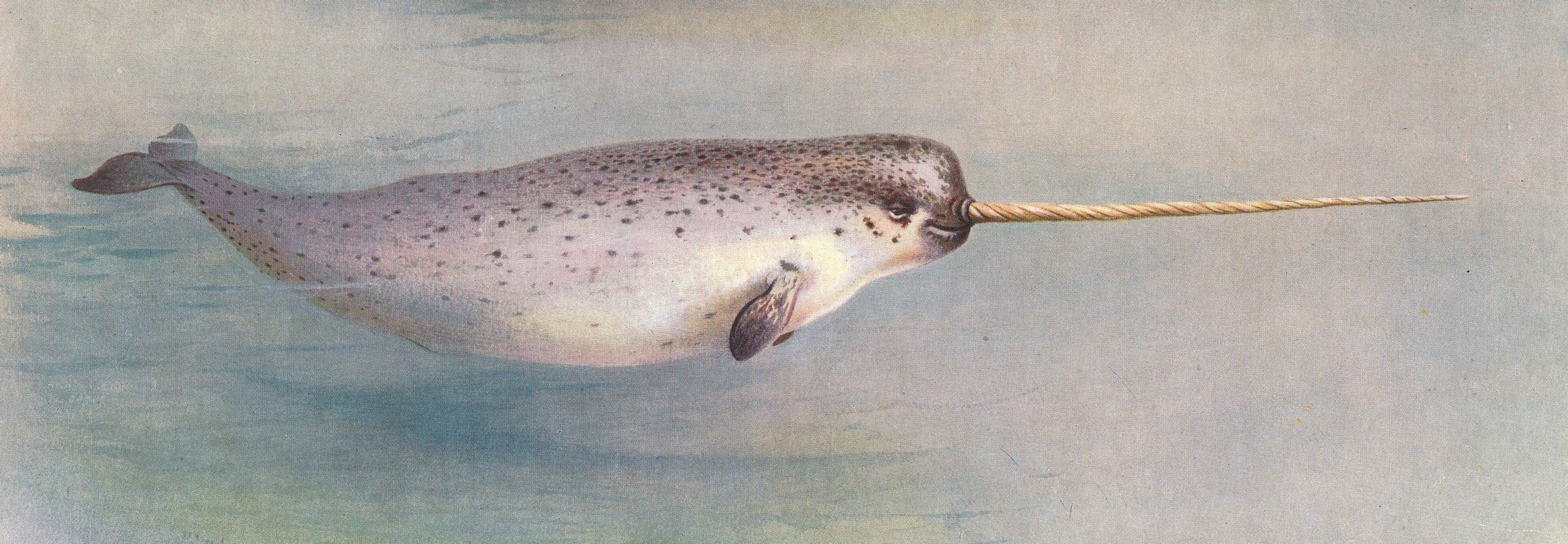
Downloads and Resources
Colors and brush I use:
I favor a simple primary “triad” plus two extra colors: Manganese Blue (“cyan”), Quinacridone Rose (“magenta”), Aureolin Yellow (“yellow”), and Burnt Sienna and Indanthrone Blue, all Daniel Smith.
I use an Isabey Squirrel Mop Travel Brush.
ROSEANN’S FINISHED PAGES—I didn’t do a world map this time! I will next episode



ATTENDEES’ Pages from the Workshop
Please post your pages on our Field Arts Community Forum! It’s free and easy to register, and private!
Field Arts Workshop: Creative Night Skies (Full Class)
How do you journal night skies? It's always been a love-hate thing for me—I love tracking the stars and planets and finding constellations, but depicting them in journals can be challenging!
In this free online workshop, I demonstrate four different approaches:
Pre-painted watercolor skies on which you can add sky components live or after a sky-viewing telescope session (a technique inspired by Alaska artist Kristin Link);
Making a cutaway peek-a-boo window showing day-and-night;
Using Sharpies and white, silver, or other metallic pens and pencils; and
Using black paper and white, silver, or other metallic pens, pencils, and paint.
WHAT YOU WILL NEED:
Journal with or sheets of watercolor paper;
Paint colors: Indigo, Pthalo Blue (Green Shade), Quinacridone Rose or similar, Burnt Sienna (mine are Daniel Smith but any brand will do);
Hair dryer;
White gel pen (the best is Uniball Signo;
White and red colored pencils;
For fun if you have them: metallic paints or pens and pencils;
Black Sharpie;
Black paper.
Here is a link to a static post with photos and more instructions:
https://www.exploringoverland.com/constantapprentice/2023/4/10/journaling-night-skies
Attendees’ Pages
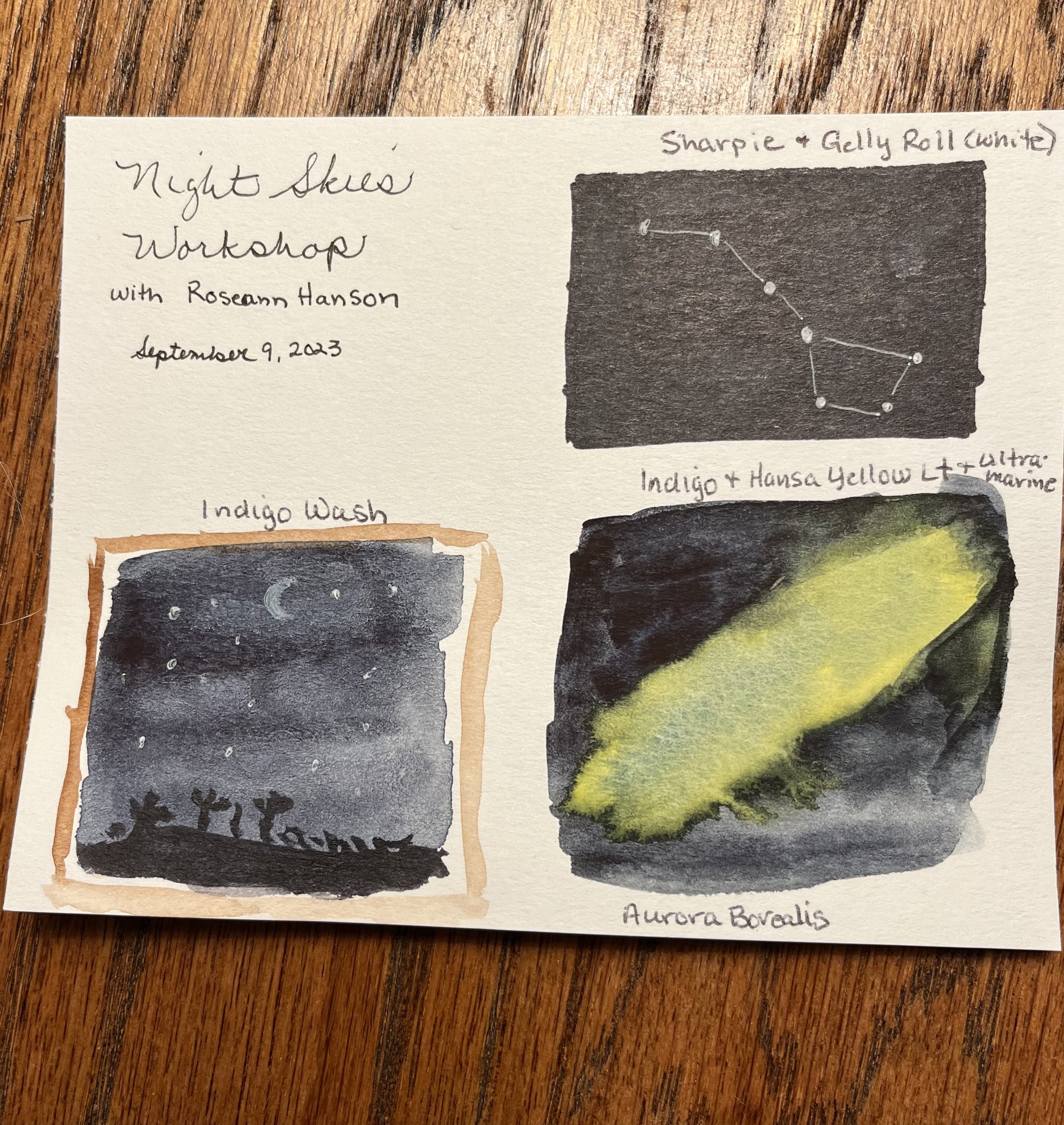

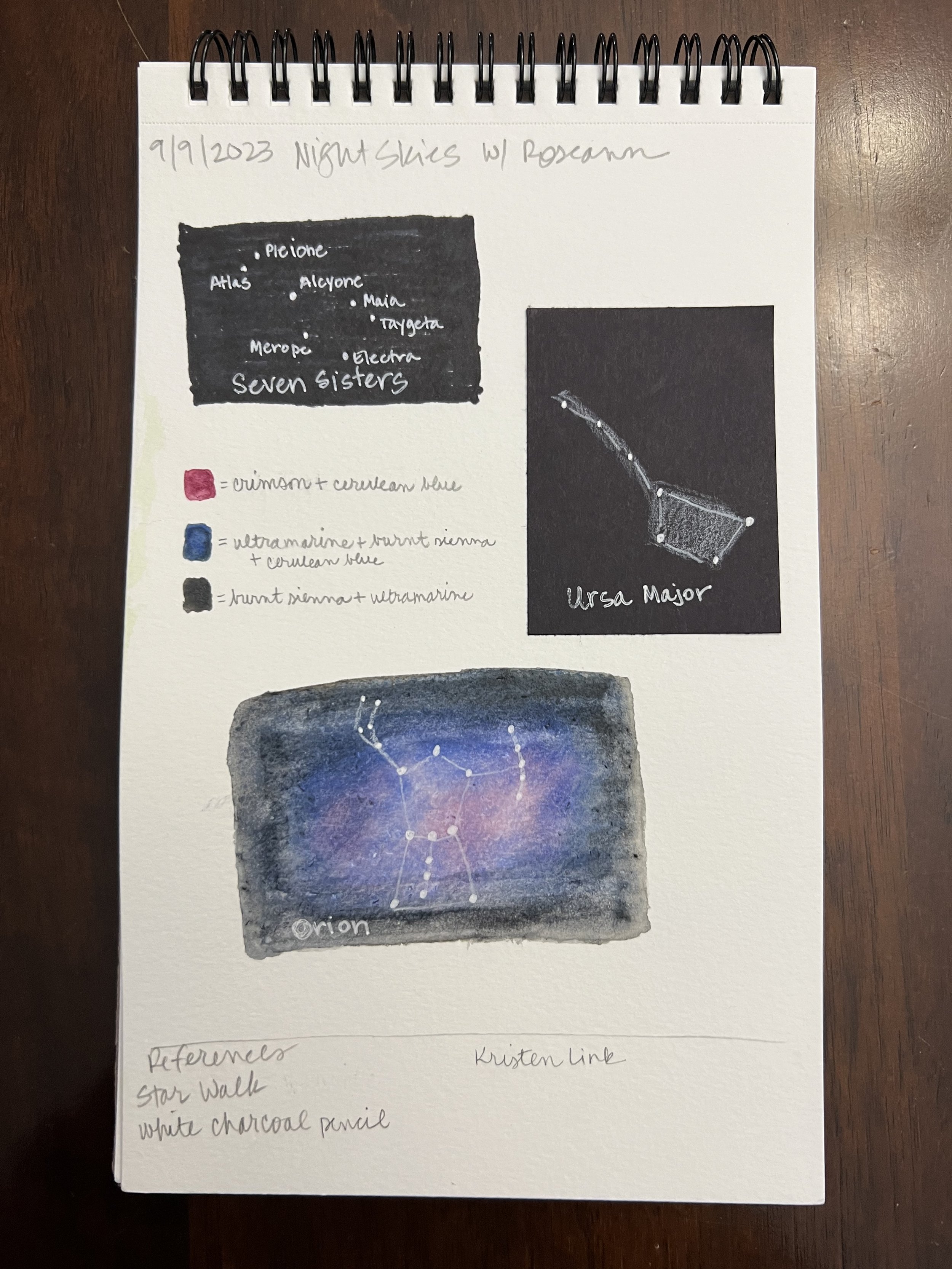
Field Arts Workshop: Around the World in 80 Trees No. 10 (Final Episode!)
Note: you may turn on closed captions by clicking the “CC” button in the video controls. You can also view full screen by clicking the Expand arrows.
Inspired by Jonathan Drori’s wonderful books Around the World in 80 Trees and Around the World Plants, we’re going to travel around the globe by region and sketch interesting, weird, iconic, or beautiful trees and tree-like plants.
Part 10: Viewer Favorites
What you’ll need: a multi-media sketchbook or an accordion style booklet (see below), pen and / or pencil for our base drawings, and then watercolor or colored pencil to quickly bring them to life.
TIP: I used a strip of heavy watercolor paper folded into four squares to create an “accordion” booklet to record my trees (8 total, 4 on each side).
Prepwork: Create a map of the world so you can sketch location points for each species (North America, Pacific, Australia Europe).
Length: 2 hours
Downloads and Resources
Books and References:
Plants of the World, hosted by Kew Royal Botanical Gardens, is an amazing resource. The hardbound book of the same name is a treasure, and I use it extensively in my research for this series.
Colors and brush I use:
I favor a simple primary “triad” plus two extra colors: Manganese Blue (“cyan”), Quinacridone Rose (“magenta”), Aureolin Yellow (“yellow”), and Burnt Sienna and Indanthrone Blue, all Daniel Smith.
I use an Isabey Squirrel Mop Travel Brush.
ROSEANN’S FINISHED ACCORDION PAGE


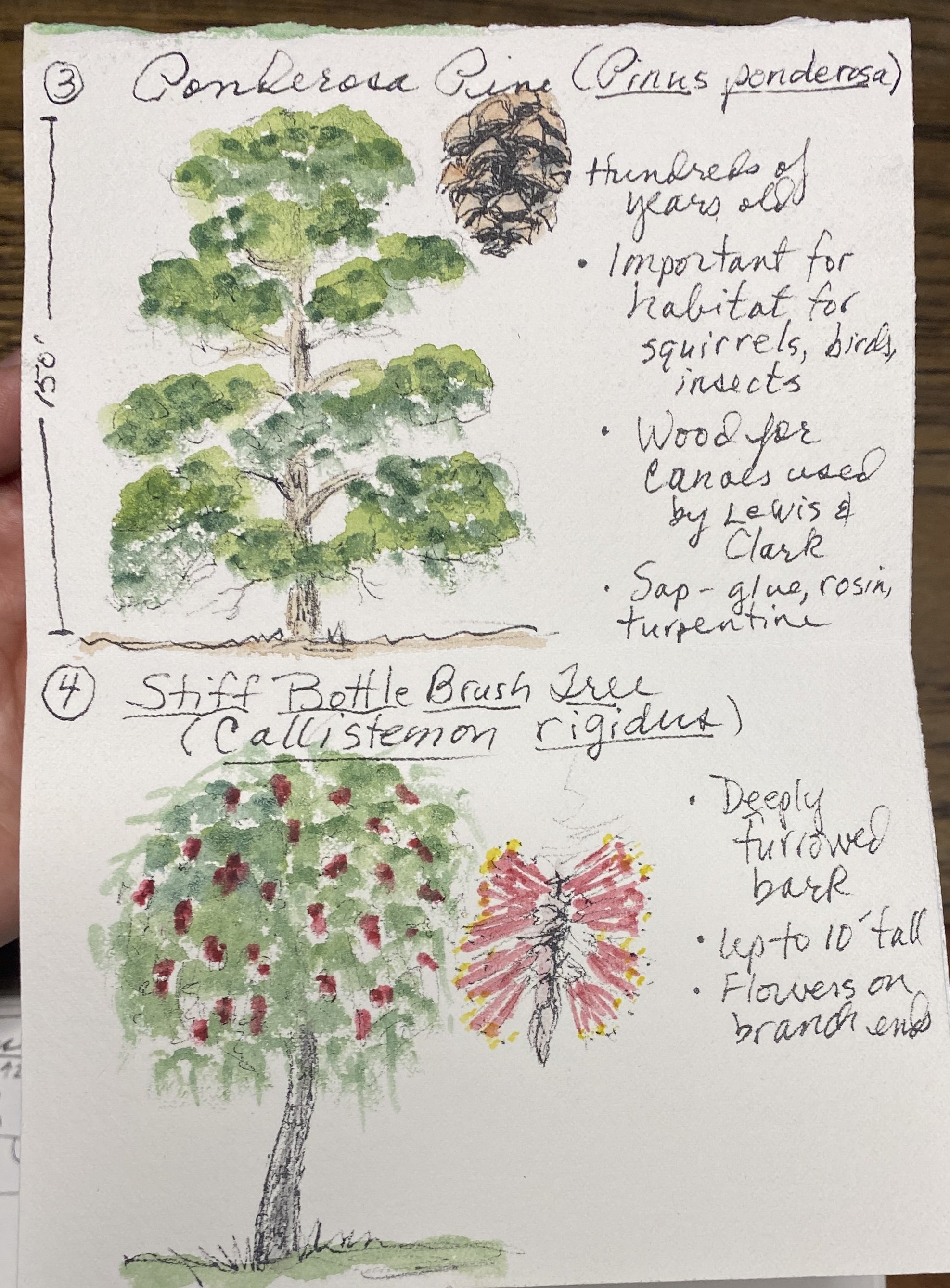


ATTENDEES’ Pages from the Workshop
Please post your pages on our Field Arts Community Forum! It’s free and easy to register, and private!
Field Arts Workshop: Around the World in 80 Trees No. 9 (Oceania)
Note: you may turn on closed captions by clicking the “CC” button in the video controls. You can also view full screen by clicking the Expand arrows.
Inspired by Jonathan Drori’s wonderful books Around the World in 80 Trees and Around the World Plants, we’re going to travel around the globe by region and sketch interesting, weird, iconic, or beautiful trees and tree-like plants.
Part 9: Oceania
What you’ll need: a multi-media sketchbook or an accordion style booklet (see below), pen and / or pencil for our base drawings, and then watercolor or colored pencil to quickly bring them to life.
TIP: I used a strip of heavy watercolor paper folded into four squares to create an “accordion” booklet to record my trees (8 total, 4 on each side).
Prepwork: have on hand a simple outline map of Oceana, taking in New Zealand to Rapa Nui, and north to Hawai’i (see resources below) so you can sketch location points for each species.
Length: 2 hours
Click here to view all past workshops!
Register for our Final Workshop No. 10 - Wild Cards—NOTE THE SPECIAL INSTRUCTIONS ON HOW TO SUBMIT YOUR DRAWINGS AND ENTER TO WIN A $50 GIFT CERTIFICATE! >>CLICK HERE<<
Downloads and Resources
Locations of the 8 species for this workshop (these are not the ranges, but the site where the specimen we sketch is located).
Books and References:
Plants of the World, hosted by Kew Royal Botanical Gardens, is an amazing resource. The hardbound book of the same name is a treasure, and I use it extensively in my research for this series.
Colors and brush I use:
I favor a simple primary “triad” plus two extra colors: Manganese Blue (“cyan”), Quinacridone Rose (“magenta”), Aureolin Yellow (“yellow”), and Burnt Sienna and Indanthrone Blue, all Daniel Smith.
I use an Isabey Squirrel Mop Travel Brush.
ROSEANN’S FINISHED ACCORDION PAGE





ATTENDEES’ Pages from the Workshop
Please send your pages and I will upload!










Field Arts Workshop: Around the World in 80 Trees No. 8 (SE Asia)
Note: you may turn on closed captions by clicking the “CC” button in the video controls. You can also view full screen by clicking the Expand arrows.
Inspired by Jonathan Drori’s wonderful books Around the World in 80 Trees and Around the World Plants, we’re going to travel around the globe by region and sketch interesting, weird, iconic, or beautiful trees and tree-like plants.
Part 8: Southeast Asia
What you’ll need: a multi-media sketchbook or an accordion style booklet (see below), pen and / or pencil for our base drawings, and then watercolor or colored pencil to quickly bring them to life.
TIP: I used a strip of heavy watercolor paper folded into four squares to create an “accordion” booklet to record my trees (8 total, 4 on each side).
Prepwork: have on hand a simple outline map of SE Asia (see resources below) so you can sketch location points for each species.
Length: 2 hours
Downloads and Resources
Locations of the 8 species for this workshop (these are not the ranges, but the site where the specimen we sketch is located).
Books and References:
Plants of the World, hosted by Kew Royal Botanical Gardens, is an amazing resource. The hardbound book of the same name is a treasure, and I use it extensively in my research for this series.
Colors and brush I use:
I favor a simple primary “triad” plus two extra colors: Manganese Blue (“cyan”), Quinacridone Rose (“magenta”), Aureolin Yellow (“yellow”), and Burnt Sienna and Indanthrone Blue, all Daniel Smith.
I use an Isabey Squirrel Mop Travel Brush.
ROSEANN’S FINISHED ACCORDION PAGE
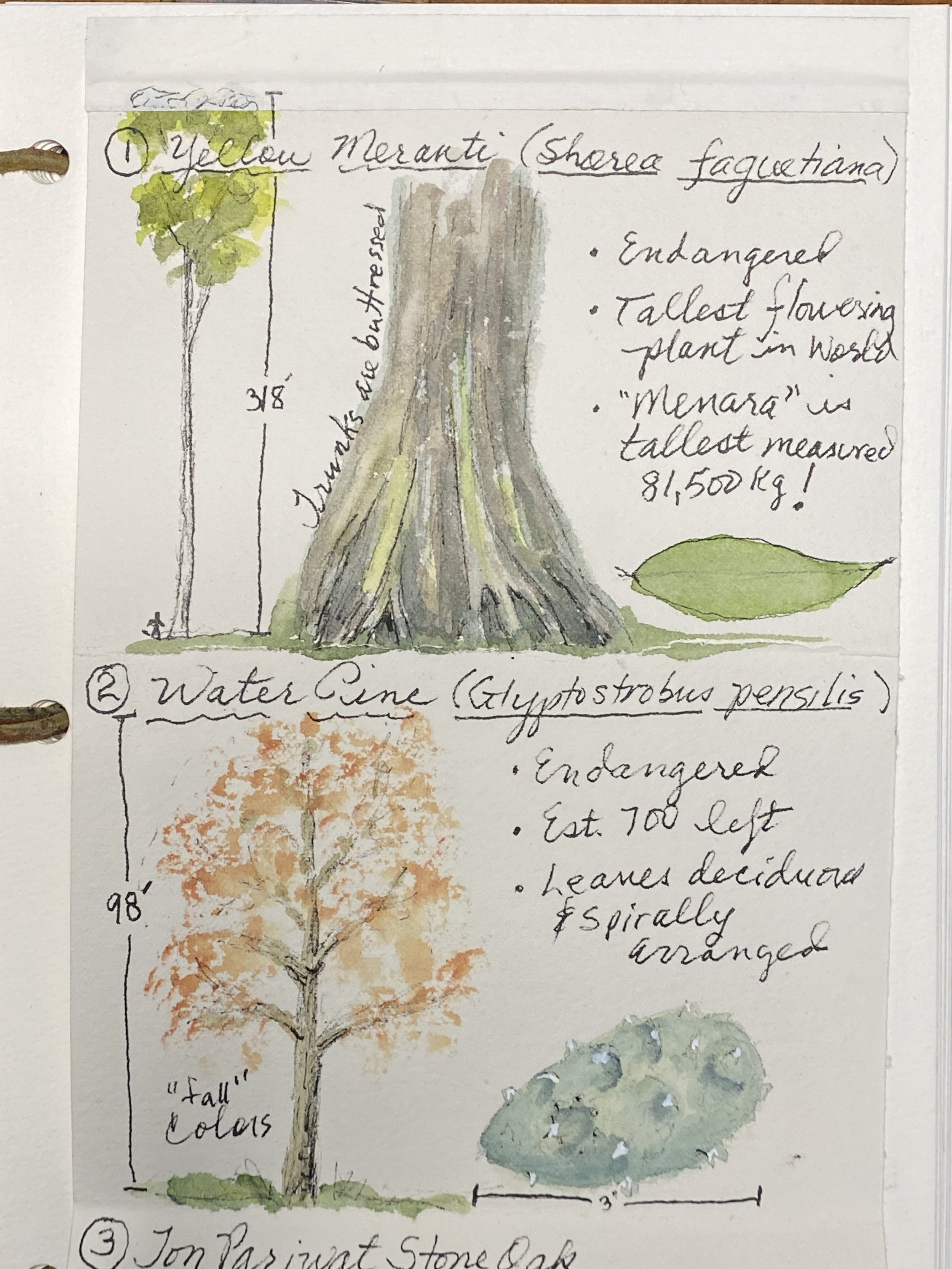
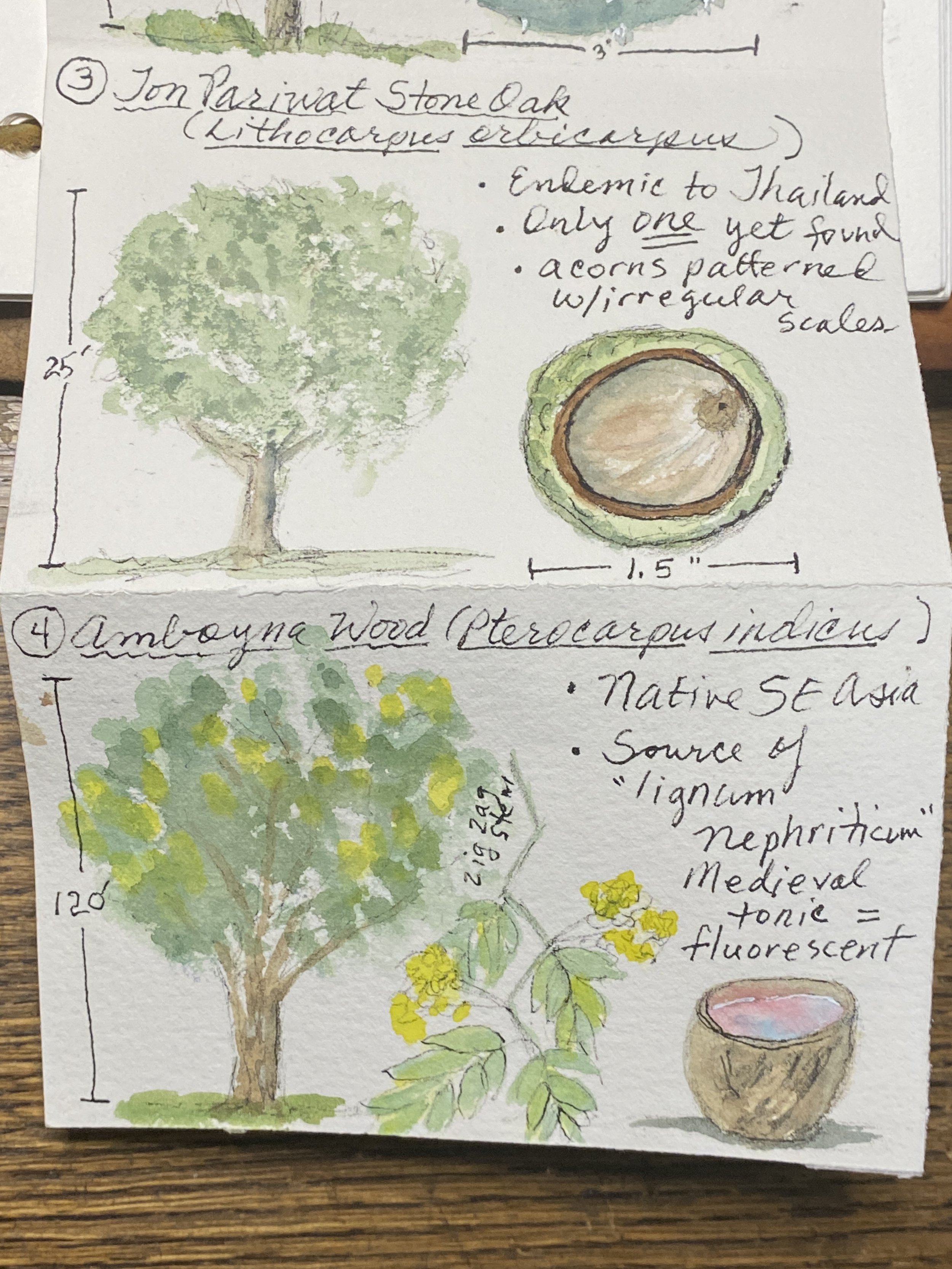
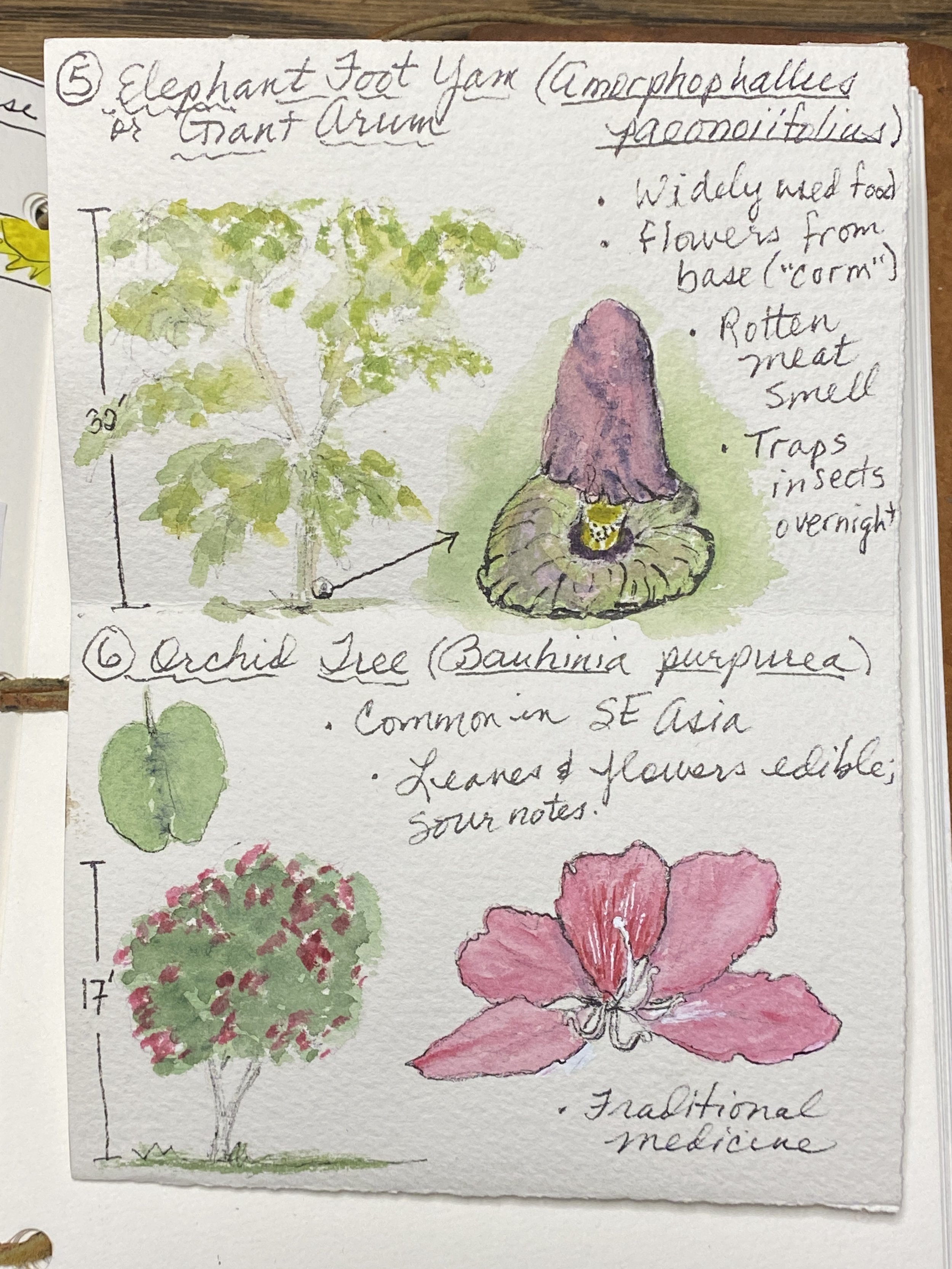
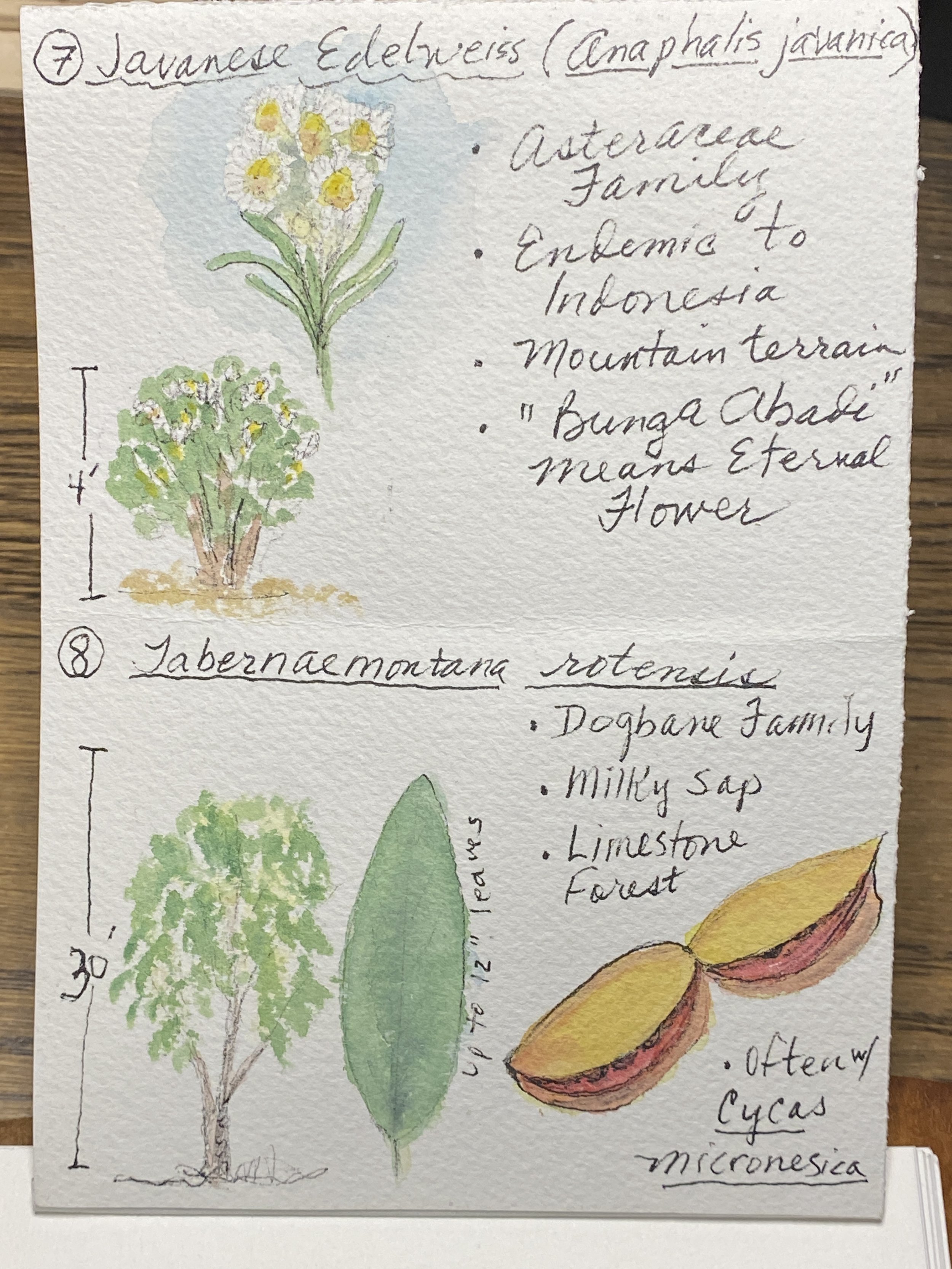
ATTENDEES’ Pages from the Workshop
Please send your pages and I will upload!




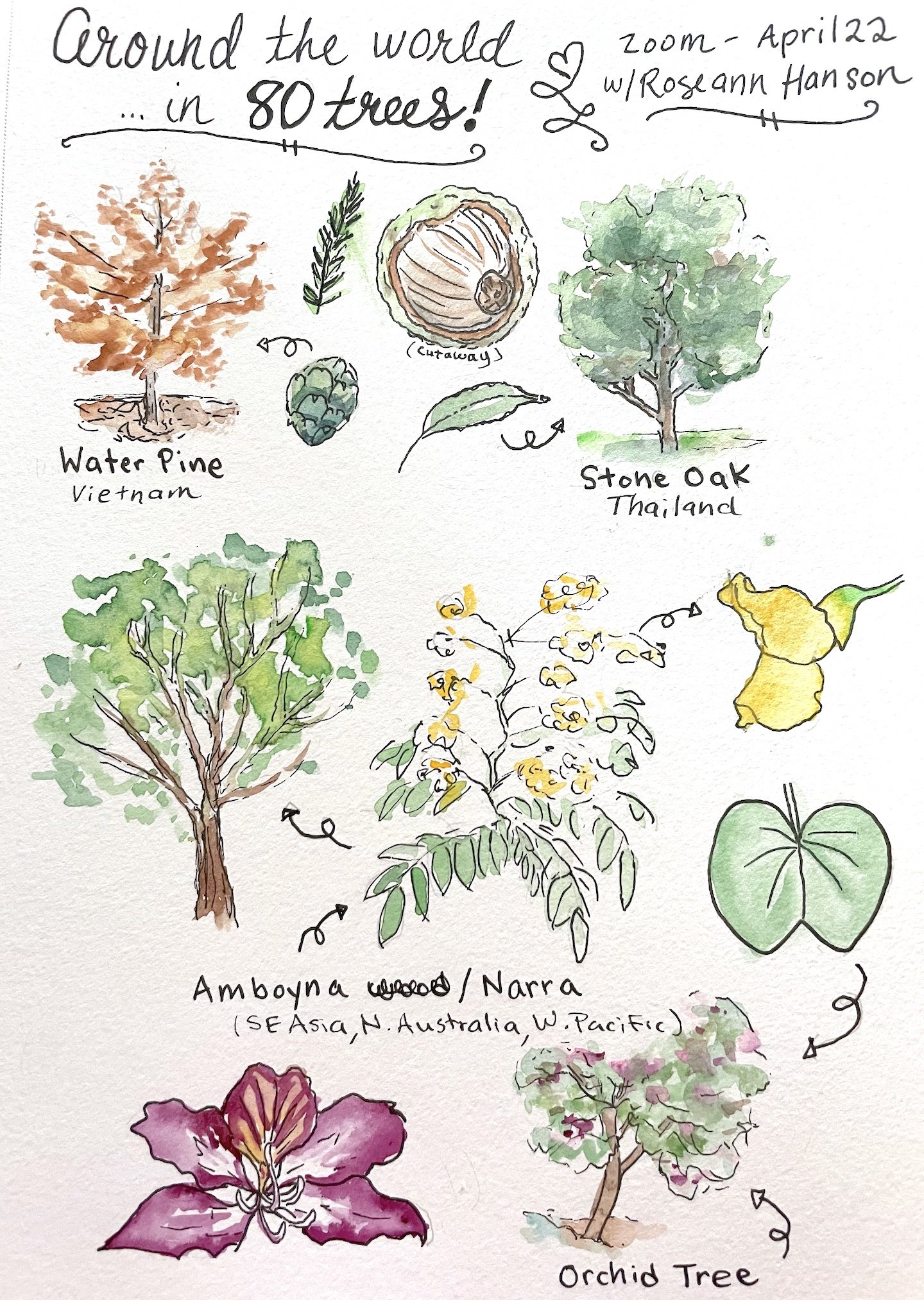
Field Arts Workshop: Around the World in 80 Trees No. 7 (Australia)
Inspired by Jonathan Drori’s wonderful books Around the World in 80 Trees and Around the World Plants, we’re going to travel around the globe by region and sketch interesting, weird, iconic, or beautiful trees and tree-like plants.
Part 7: Australia
What you’ll need: a multi-media sketchbook or an accordion style booklet (see below), pen and / or pencil for our base drawings, and then watercolor or colored pencil to quickly bring them to life.
TIP: I used a strip of heavy watercolor paper folded into four squares to create an “accordion” booklet to record my trees (8 total, 4 on each side).
Prepwork: have on hand a simple outline map of Asia (see resources below) so you can sketch location points for each species.
Length: 2 hours
Downloads and Resources
Locations of the 8 species for this workshop (these are not the ranges, but the site where the specimen we sketch is located).
Books and References:
Plants of the World, hosted by Kew Royal Botanical Gardens, is an amazing resource. The hardbound book of the same name is a treasure, and I use it extensively in my research for this series.
Colors and brush I use:
I favor a simple primary “triad” plus two extra colors: Manganese Blue (“cyan”), Quinacridone Rose (“magenta”), Aureolin Yellow (“yellow”), and Burnt Sienna and Indanthrone Blue, all Daniel Smith.
I use an Isabey Squirrel Mop Travel Brush.
ROSEANN’S FINISHED ACCORDION PAGE

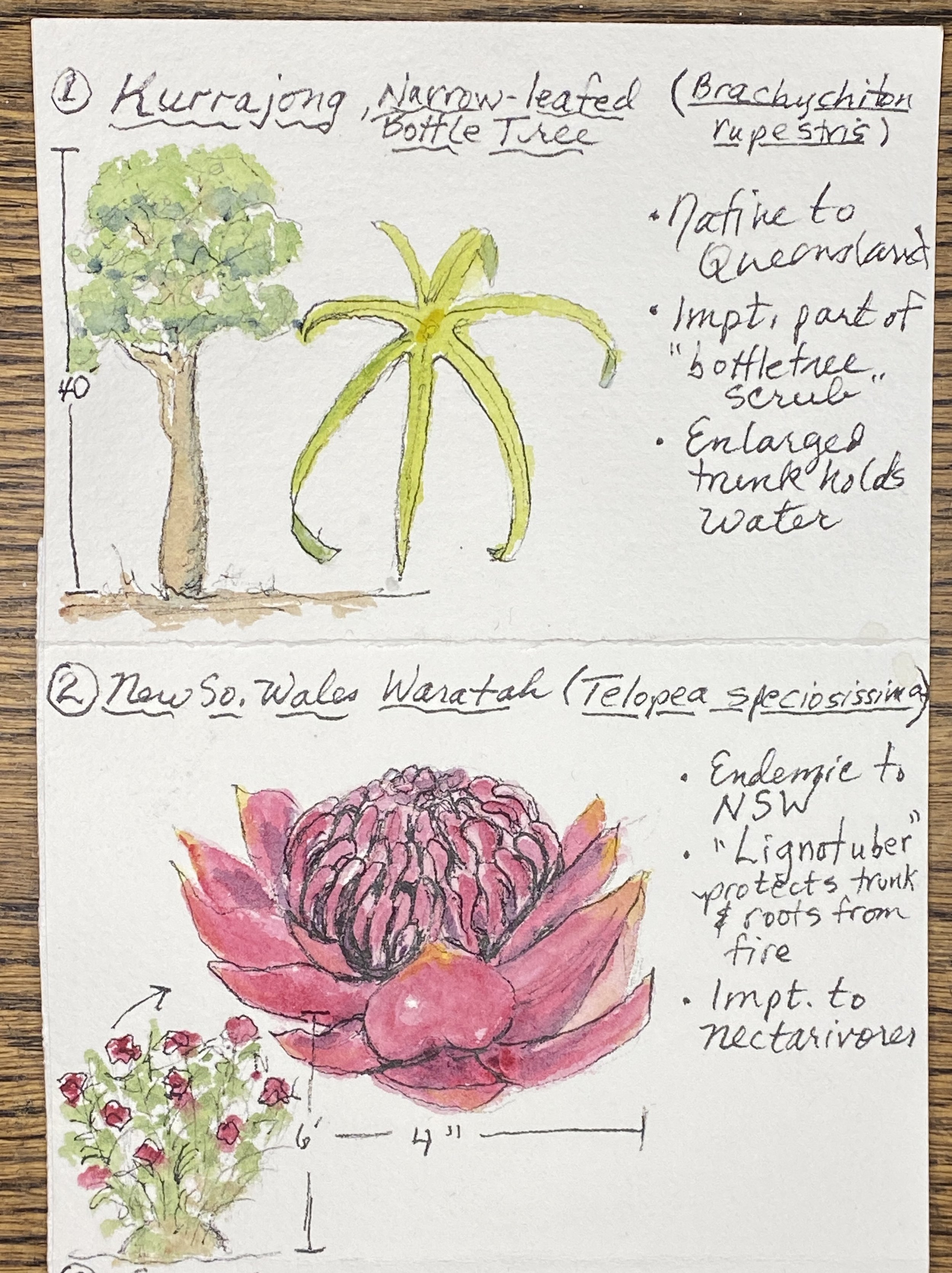
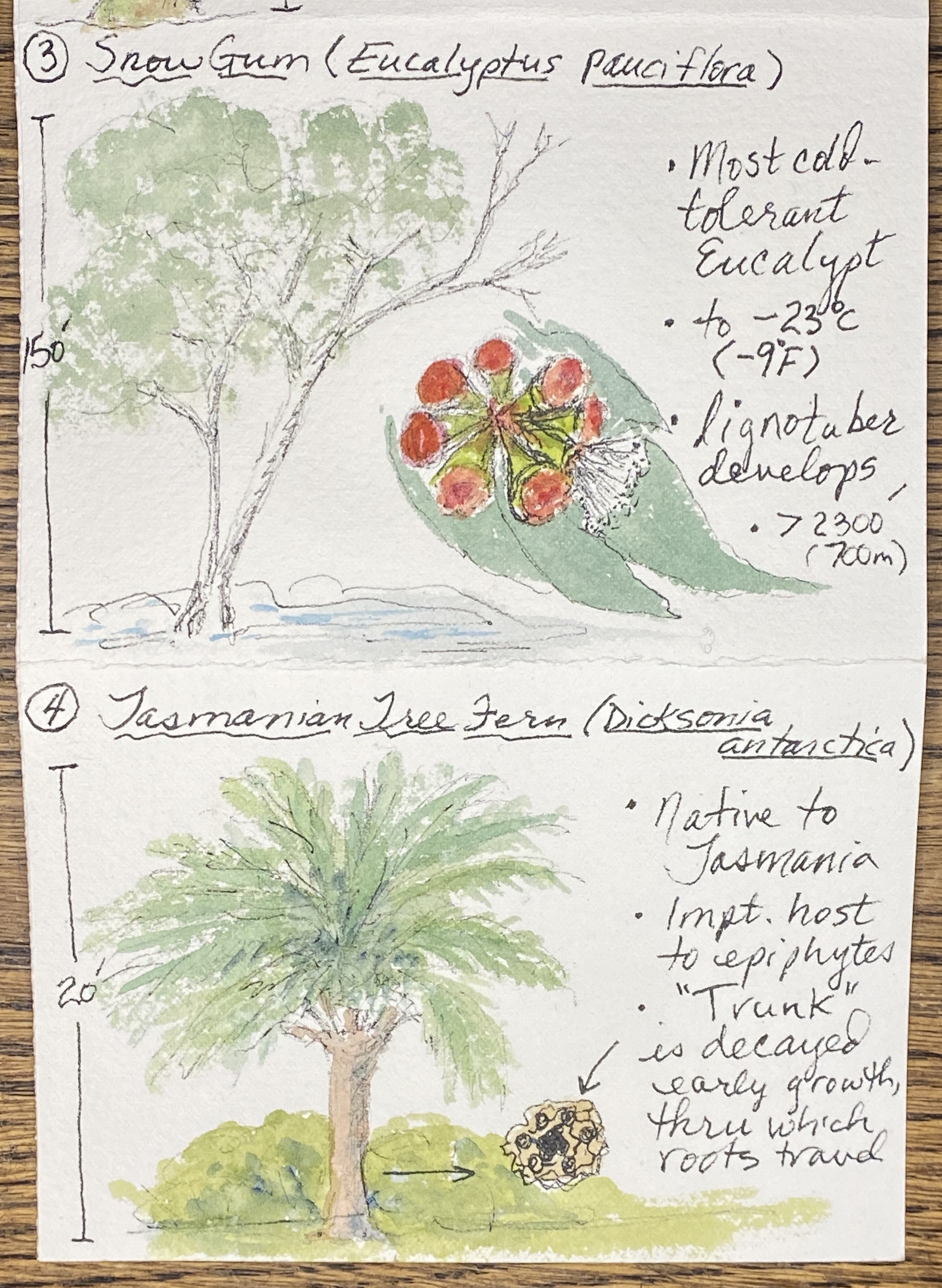
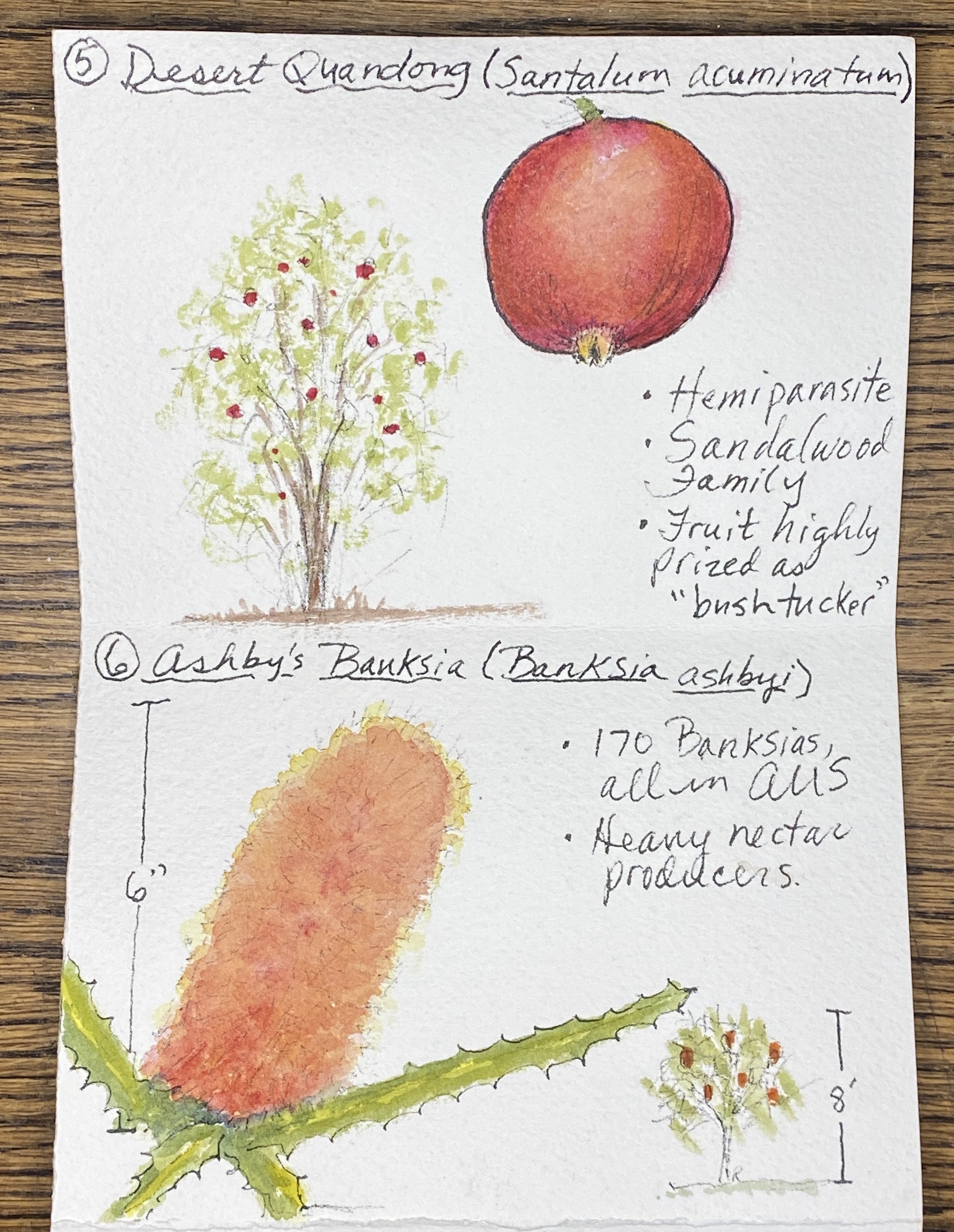
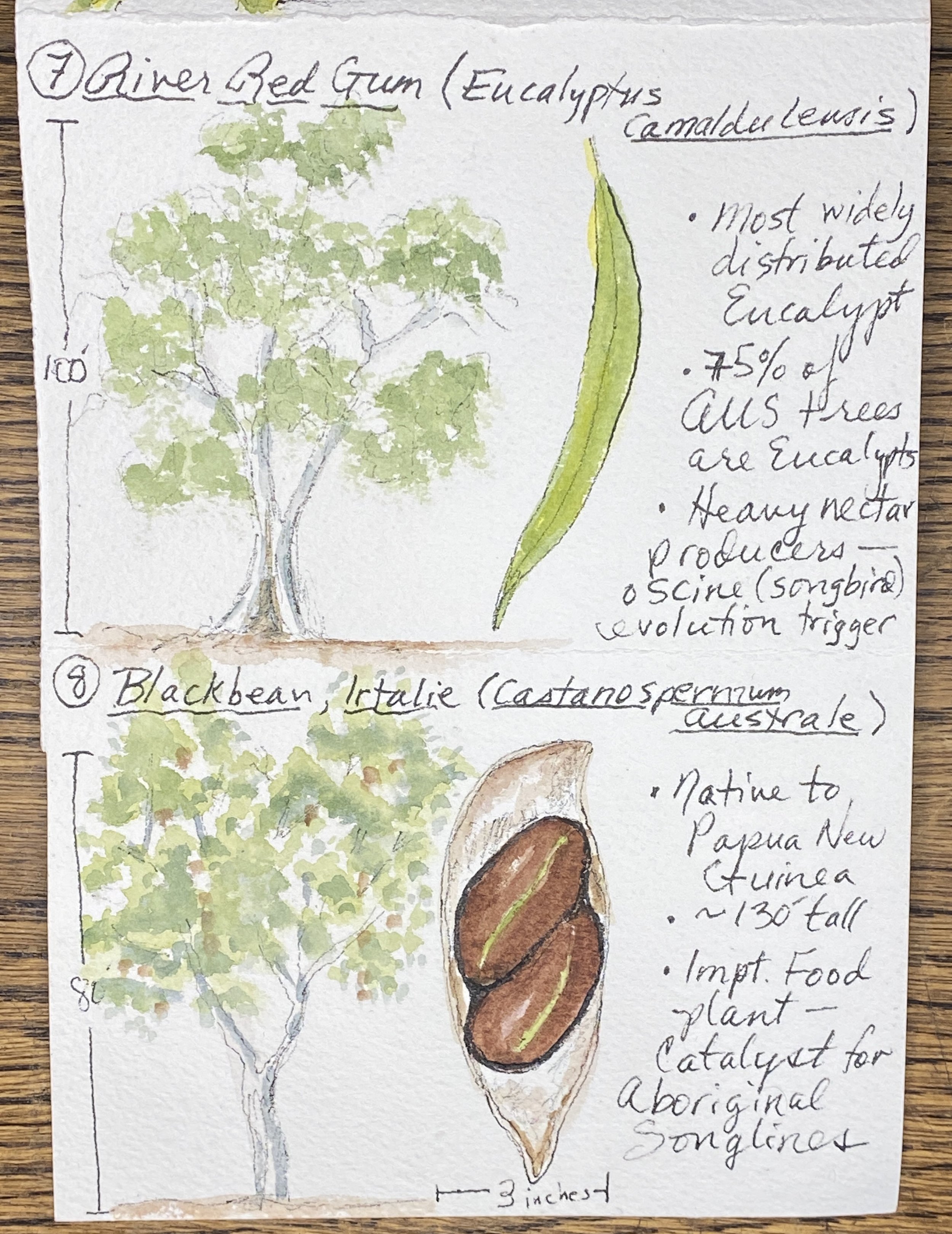
ATTENDEES’ Pages from the Workshop
Please send your pages and I will upload!

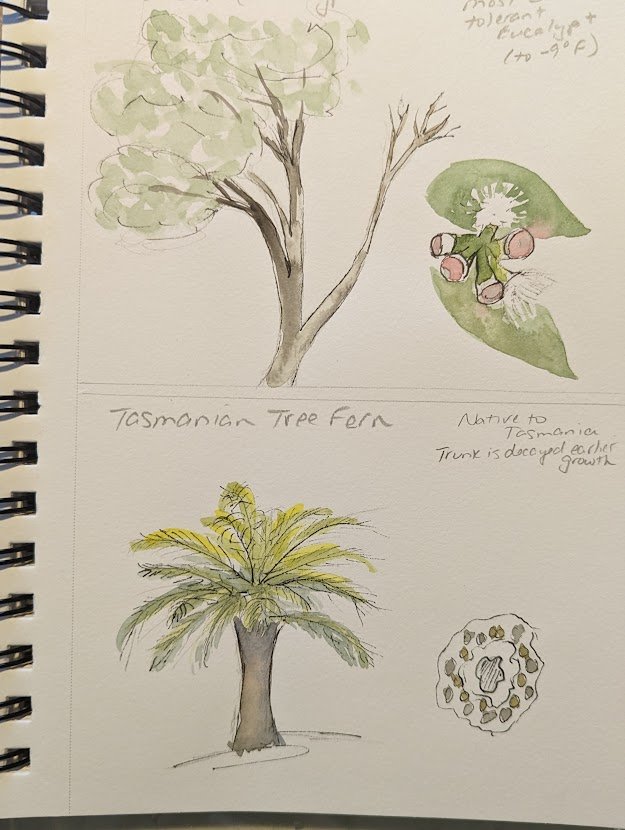
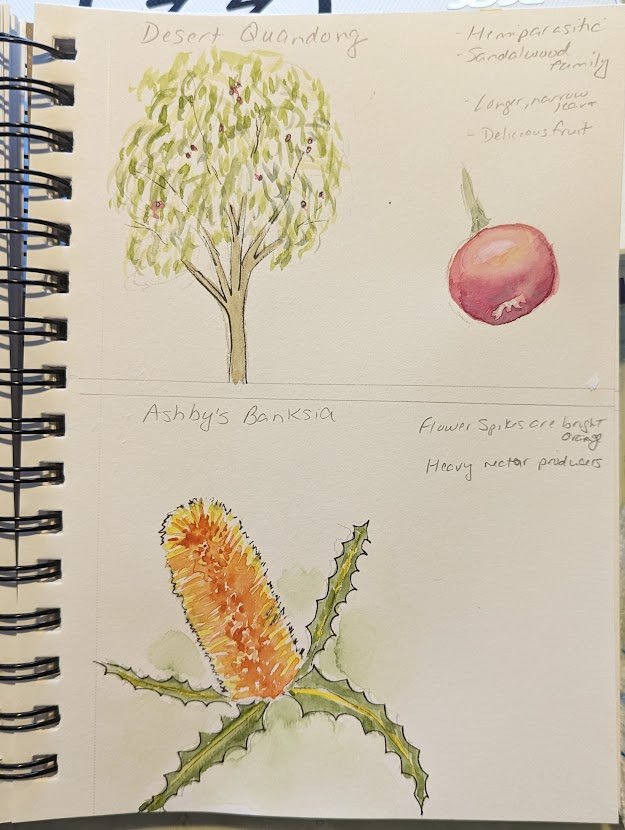
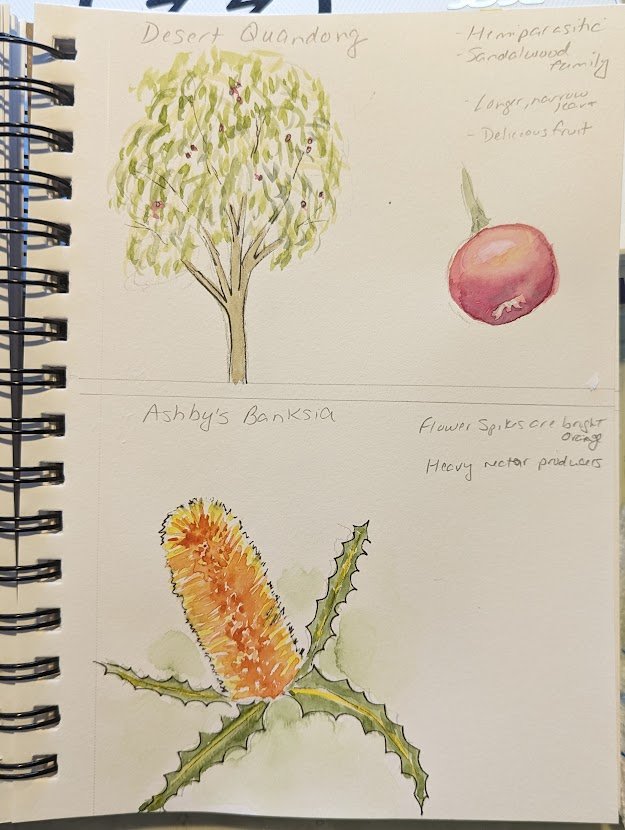

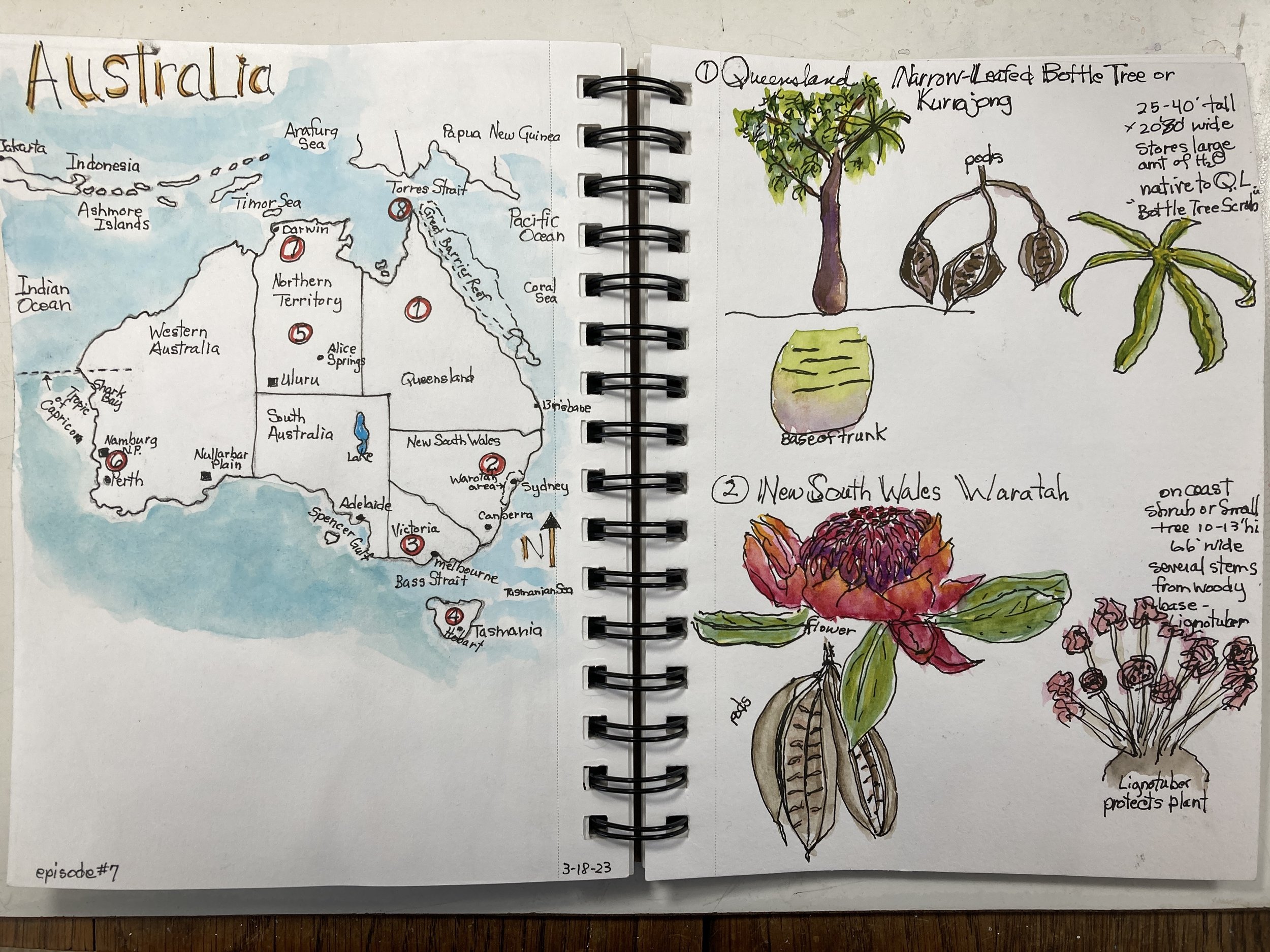
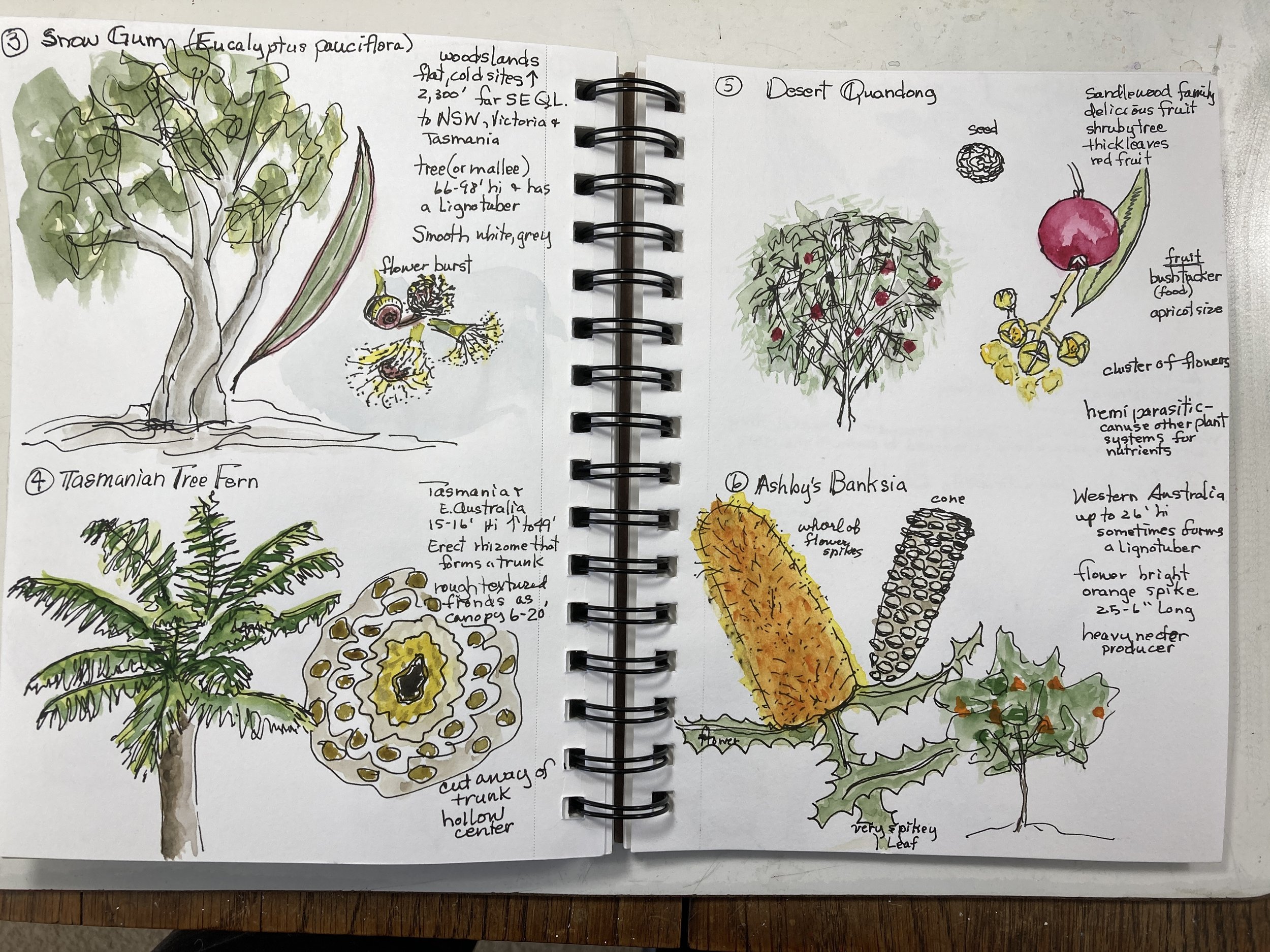
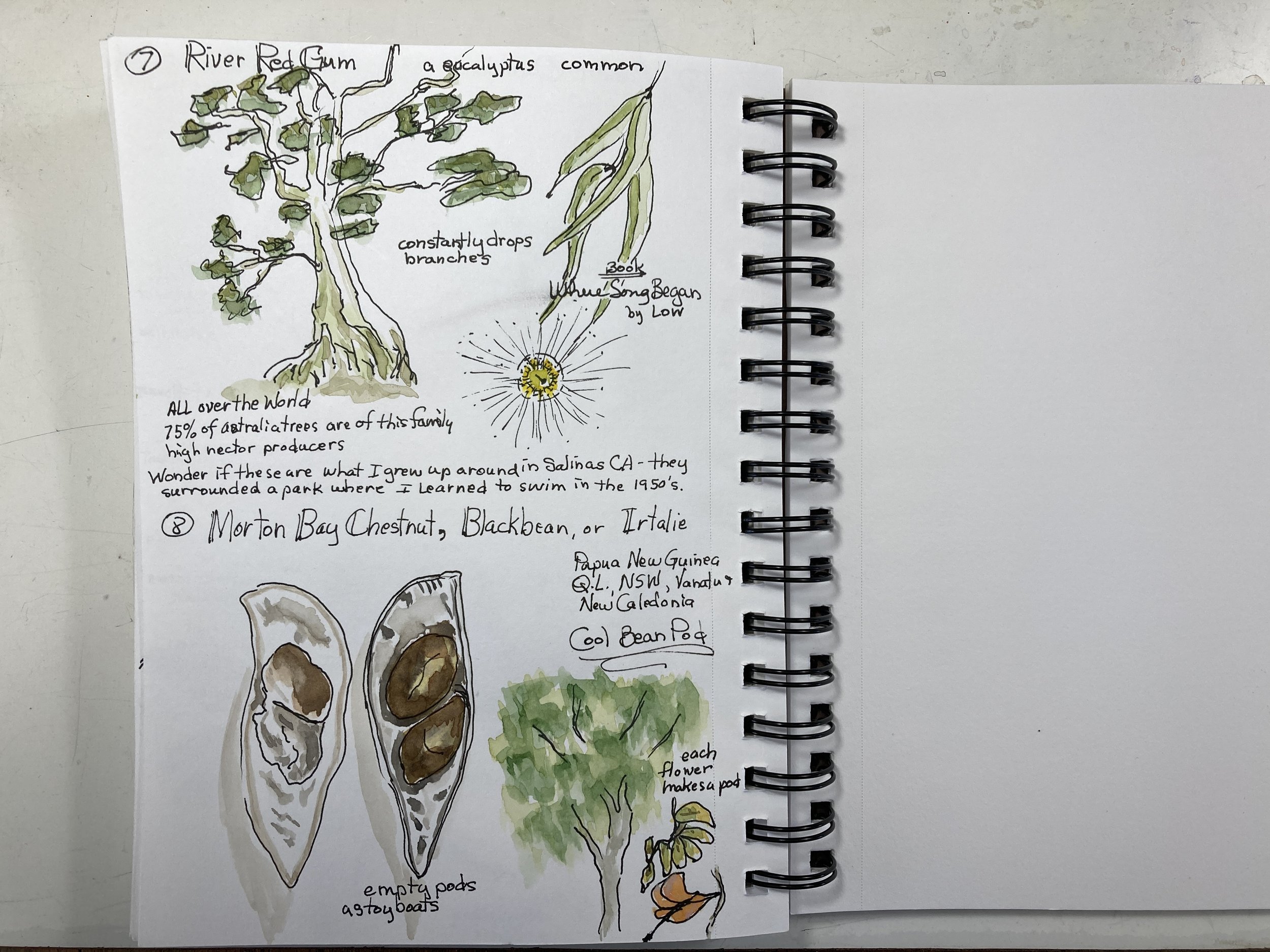







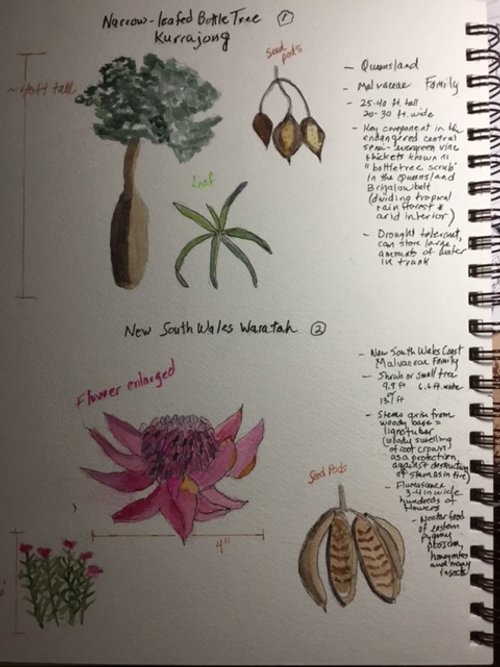


Field Arts Workshop: Around the World in 80 Trees No. 6 (Asia - Part 2)
Inspired by Jonathan Drori’s wonderful books Around the World in 80 Trees and Around the World Plants, we’re going to travel around the globe by region and sketch interesting, weird, iconic, or beautiful trees and tree-like plants.
Part 6: Asia - Part 2
What you’ll need: a multi-media sketchbook or an accordion style booklet (see below), pen and / or pencil for our base drawings, and then watercolor or colored pencil to quickly bring them to life.
TIP: I used a strip of heavy watercolor paper folded into four squares to create an “accordion” booklet to record my trees (8 total, 4 on each side).
Prepwork: have on hand a simple outline map of Asia (see resources below) so you can sketch location points for each species.
Length: 2 hours
Downloads and Resources
Locations of the 8 species for this workshop (these are not the ranges, but the site where the specimen we sketch is located).
Tip: Print or create an outline of Asia in your journal so you can mark the site locations of our sketched species.
Books and References:
Plants of the World, hosted by Kew Royal Botanical Gardens, is an amazing resource. The hardbound book of the same name is a treasure, and I use it extensively in my research for this series.
Colors and brush I use:
I favor a simple primary “triad” plus two extra colors: Manganese Blue (“cyan”), Quinacridone Rose (“magenta”), Aureolin Yellow (“yellow”), and Burnt Sienna and Indanthrone Blue, all Daniel Smith.
I use an Isabey Squirrel Mop Travel Brush.
ROSEANN’S FINISHED ACCORDION PAGE
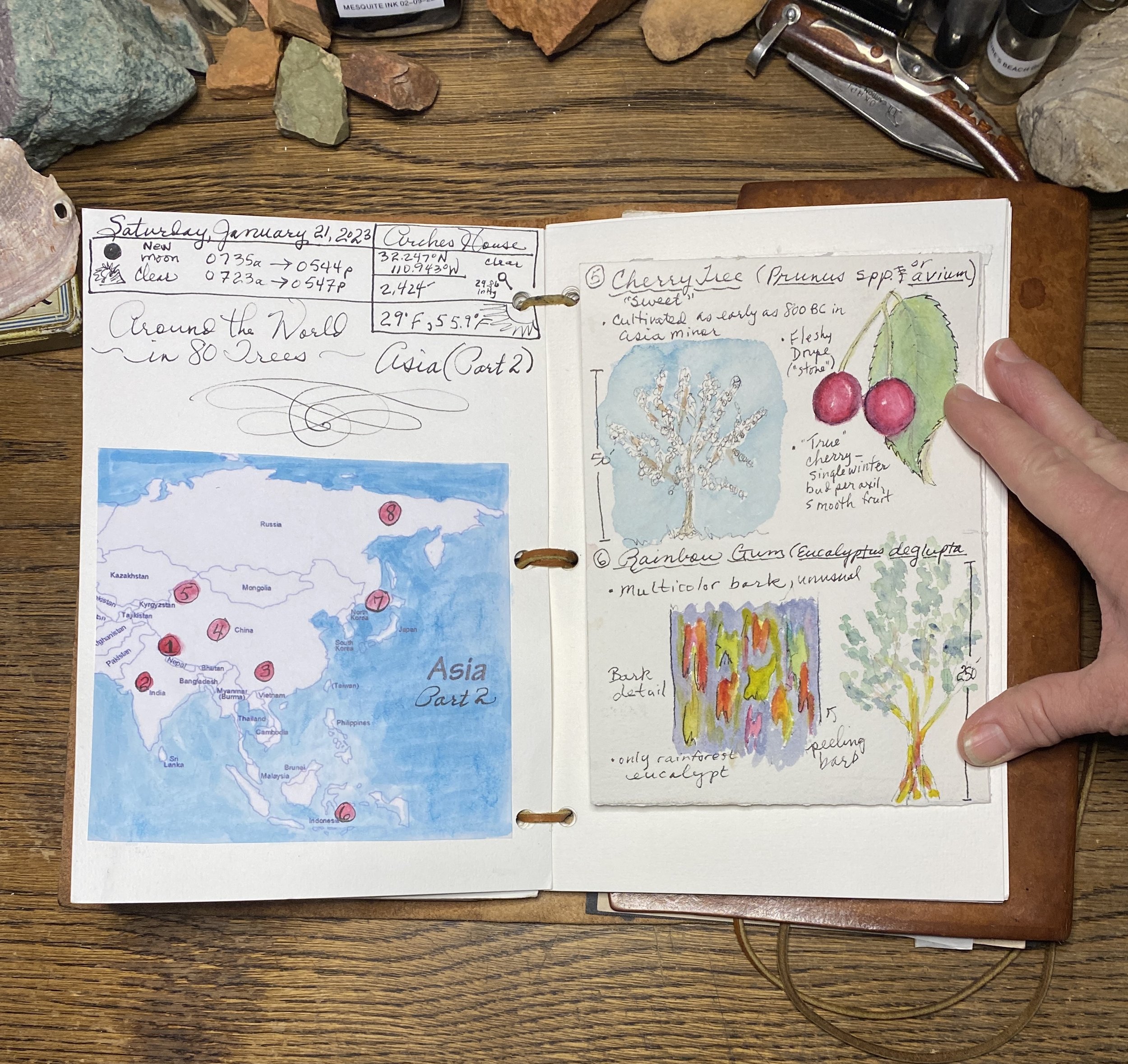
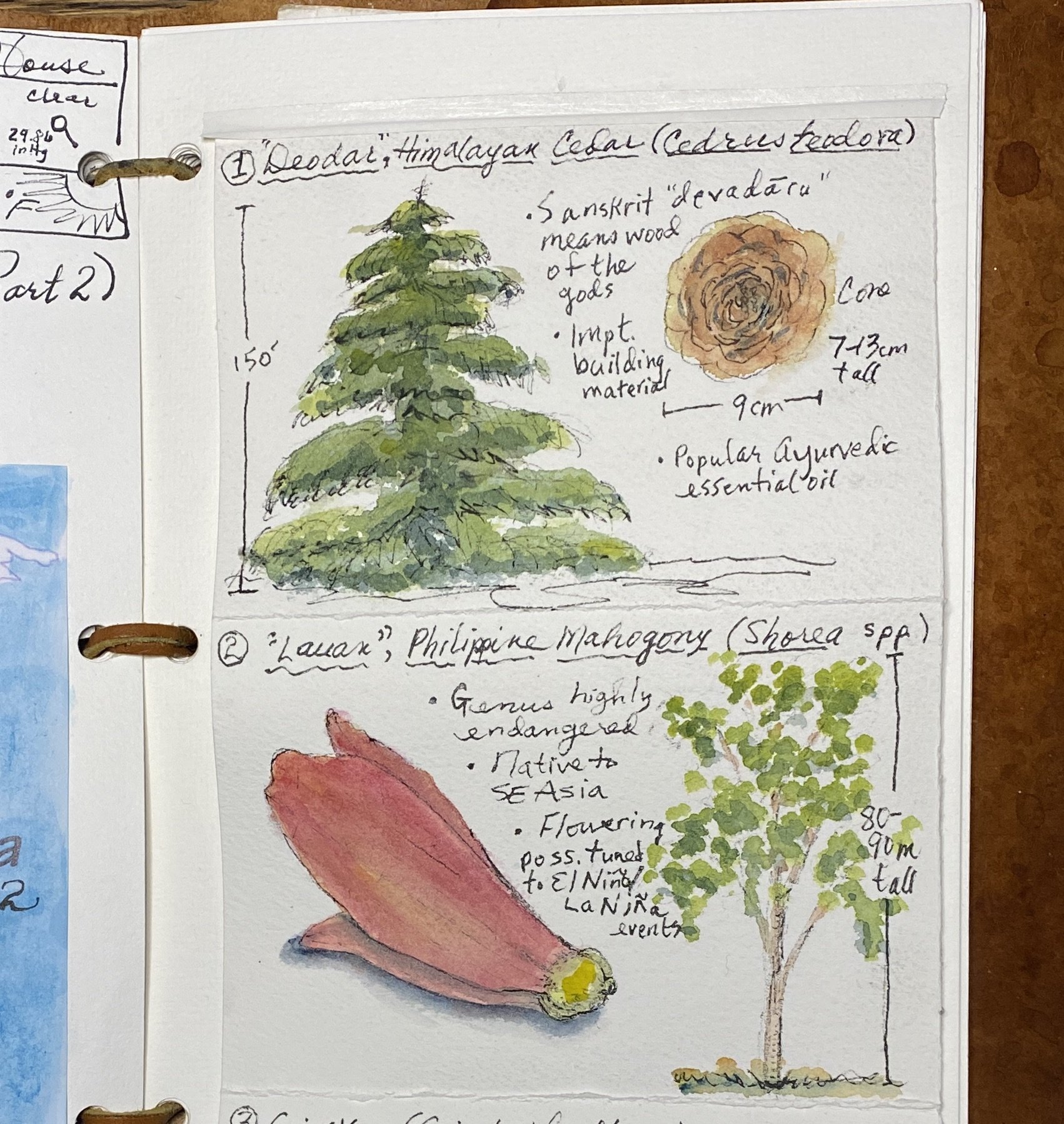
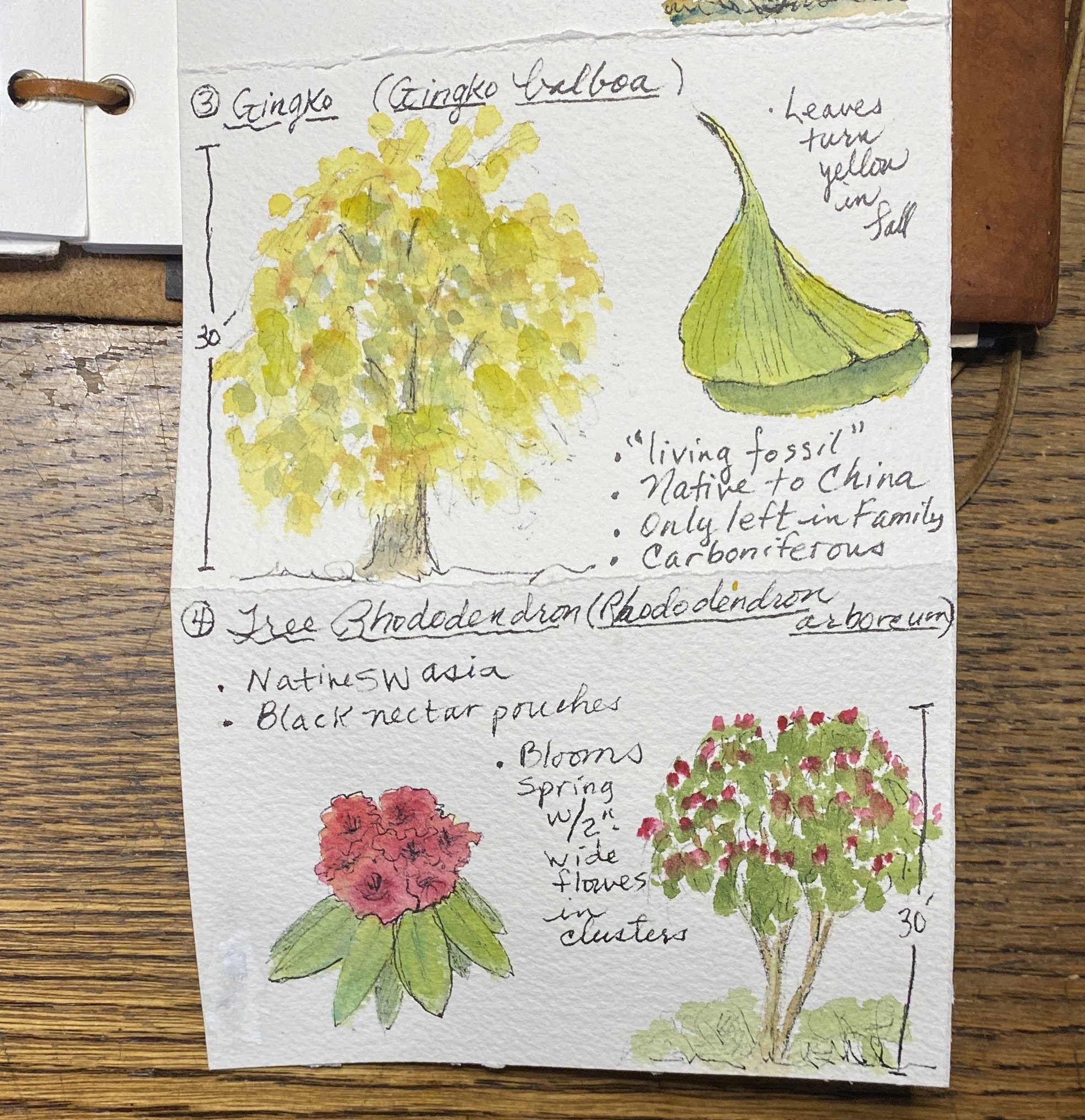

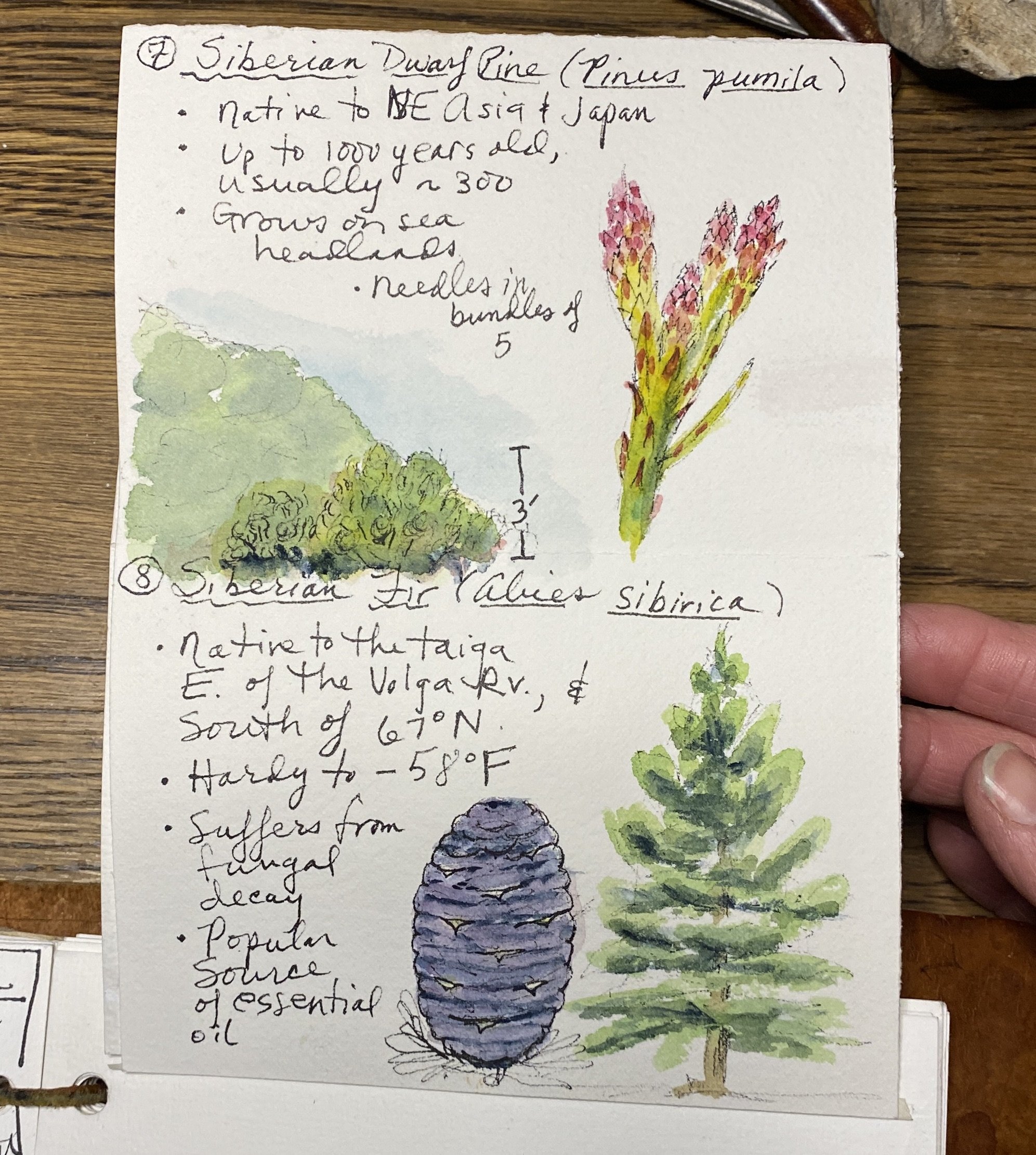
ATTENDEES’ Pages from the Workshop
Please send your pages and I will upload!
Field Arts Workshop: Around the World in 80 Trees No. 5 (Asia - Part 1)
Inspired by Jonathan Drori’s wonderful books Around the World in 80 Trees and Around the World Plants, we’re going to travel around the globe by region and sketch interesting, weird, iconic, or beautiful trees and tree-like plants.
Part 4: Asia - Part 1!
What you’ll need: a multi-media sketchbook or an accordion style booklet (see below), pen and / or pencil for our base drawings, and then watercolor or colored pencil to quickly bring them to life.
TIP: I used a strip of heavy watercolor paper folded into four squares to create an “accordion” booklet to record my trees (8 total, 4 on each side).
Prepwork: have on hand a simple outline map of Asia (see resources below) so you can sketch location points for each species.
Length: 2 hours
Downloads and Resources
Locations of the 8 species for this workshop (these are not the ranges, but the site where the specimen we sketch is located).
Tip: Print or create an outline of Asia in your journal so you can mark the site locations of our sketched species.
Books and References:
Plants of the World, hosted by Kew Royal Botanical Gardens, is an amazing resource. The hardbound book of the same name is a treasure, and I. use it extensively in my research for this series.
Colors I use:
I favor a simple primary “triad” plus two extra colors: Manganese Blue (“cyan”), Quinacridone Rose (“magenta”), Aureolin Yellow (“yellow”), and Burnt Sienna and Indanthrone Blue, all Daniel Smith.
ROSEANN’S FINISHED ACCORDION PAGE






ATTENDEES’ Pages from the Workshop
Please send your pages and I will upload!
